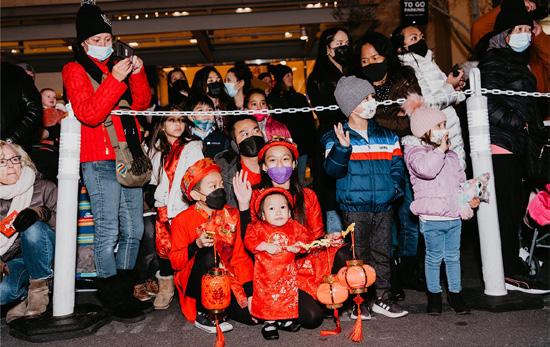Racial Equity in Real Estate Development Practices
A recent ULI report, 10 Principles for Embedding Racial Equity in Real Estate Development (Schoder 2022, 11), explicitly acknowledges the industry’s role in “creating and perpetuating racial injustices that continue to this day.” Further, it posits that the industry “has a responsibility and opportunity to reckon with that history and remedy its legacy of health, economic, and other disparities in communities today.” The report recognizes that ULI, as an organization created by and representing the real estate industry, “has often played an explicit or implicit role in perpetuating inequities” and suggests 10 principles that real estate professionals should adopt to make racial equity a core part of their practice.

prestigious awards, the ULI Prize for Visionaries in Urban Development. Nichols was a highly successful MPC developer but widely known for creating whitesonly communities. In taking this step, Ed Walter, ULI’s global chief executive at the time, stated that the racist element of Nichols’s legacy “is clearly inconsistent with our mission and values”; the decision to remove his name “is a critical step in our commitment to addressing the racial injustices of the past and to improving the diversity and inclusivity of our organization and industry going forward.”
Despite this legacy, at their best, MPCs have been a testbed for innovative and thought-provoking real estate development practice. Postwar suburbs of America experimented with housing mass production techniques; in the 1960s and 1970s, some of these communities tried to counter the patterns of racial segregation and housing discrimination that dominated the U.S. housing market prior to the passage of the Civil Rights Act; in the 1980s and beyond, the new urbanist and smart-growth planning and design principles that have become the canons of good planning and development were first adopted, tested, and proved in MPCs. Though the practice of building
new communities on greenfield sites itself is subject to criticism given its contribution to urban sprawl, many MPCs advance environmentally sustainable development practices within their boundaries: Conservation easements, designing with nature, and other techniques (e.g., low-impact design, compact development, and green building design) are common.
This report was undertaken in that light and began with several questions: Can MPCs, once the epicenter of racial discrimination and segregation, break free of the past? Can planned communities be designed to be truly diverse and inclusive? What role can developers play in creating diverse, equitable, and inclusive communities? To answer these questions, the author looked to industry-leading communities and the professionals behind those communities for insight and guidance on achieving diverse, equitable, and inclusive communities.
Diversity, in this report, captures and measures a multitude of characteristics, including, but not limited to, race, class, ethnicity, gender, age, sexual orientation, disability status, and familial status. Therefore, the report uses different measures of diversity to convey
4 Contents / Introduction Creating Diverse and Inclusive Communities
the level of diversity in the communities studied. Following Schoder (2022), equity is defined as just and fair inclusion of every member of the society in ways that allow everyone to participate, prosper, and reach their full potential. Inclusivity refers to the sense of openness to individuals and groups regardless of their backgrounds and opinions. Identification of successful communities started from financial success: The list initially comprised communities that had been repeatedly featured as the nation’s top selling communities and was later supplemented by peer recommendation.
As it turns out, this sample of the most successful MPCs was implicitly, if not explicitly, undergirded by the values of diversity and inclusion. The developers behind these communities embraced diversity, not just for the sake of diversity, but because they believed that diversity is good for business. From those developers’ experiences, lessons for the broader real estate community can be extracted for creating diverse and inclusive communities. The seven principles identified (and later elaborated on) in the report can be integrated into the planning, design, and operations of a community, as well as into a development team’s culture and practice. Community developers do not fully control the homebuying process, and they always work in partnership with homebuilders and realtors. However, by adopting and embracing these principles, developers can essentially create the backbone of diverse and inclusive communities.
A significant limitation of the report—and the community development practice more broadly— must be acknowledged up front. Despite the depth and breadth of promising practices identified that advance diversity and inclusion in planned communities, even the most innovative communities have fallen short in advancing equity. This report finds that it is relatively easier, and financially preferable, for community developers to embrace diversity and inclusion; however, remediating existing racial, ethnic, and socioeconomic inequities by,
for example, providing housing that is affordable to very low-income households, has real financial implications and thus will not be proactively pursued by developers. This shortcoming is discussed in further detail in the Conclusion.
Methodology
This report begins by reviewing the history of community development practice, particularly its role in promoting and cementing housing segregation and discrimination, on the one hand, and attempts to counter such injustices, on the other. Understanding this history allows practitioners to comprehend the landscape in which they operate and the legacies they inherit either willingly or unwillingly. History teaches us lessons, both good and bad, and allows us to develop context-sensitive solutions.
The main section of the report elaborates on the seven principles for diversity and inclusion. This section is heavily based on primary empirical data collected from the studied communities and their developers. The data collection involved interviews with 35 industry professionals; survey questionnaires completed on 29 communities; and a review of ULI proceedings, other documentation of exemplary MPCs, administrative data from municipalities, census data, entitlement documents, and marketing materials. A complete list of the surveyed communities and their basic information can be found in the appendix.
The studied communities and their developers were selected for their proven record of financial success. Most have appeared on the list of top-selling MPCs published by RCLCO, one of the industry’s top consulting firms.1 A compilation of RCLCO lists from 2010 reveals that over 38 percent of top-selling MPCs are in Texas; about 25 percent are in Florida and the Carolinas; another 15 percent are in California; and Arizona, Colorado, and Nevada each account for about 5 percent.
5 Contents / Introduction Creating Diverse and Inclusive Communities
Surveyed Communities and Their Developer Type
The goal was to select a sample that reflects the regional distribution observable in the RCLCO lists. More than half of the selected communities are in Texas, Florida, the Carolinas, and other southern states; a few are located elsewhere—Nevada, the Northwest, and Colorado. California’s representation is low because most communities in California were developed in the 1990s and the early 2000s and were completely sold out at the time of the study. (See map. See also figure 1.)
Not all the studied communities appear on the RCLCO lists. Some were selected for their industryleading efforts, based on recommendations from interviewees. Others were included because they are smaller, yet successful, projects of Brookfield Properties, a national-level community developer heavily represented in this report. In addition, in 2021, Brookfield acquired Newland, a national community developer, and thus many of the communities studied

State
surveyed Florida 8 Texas 6 Arizona 3 North Carolina 3 California 2 Georgia 2 Colorado 1 Nevada 1 Oregon 1 South Carolina 1 Washington 1 Total 29
Figure 1. Surveyed Communities, by State
Communities
6 Contents / Introduction Creating Diverse and Inclusive Communities
were initiated and developed as Newland communities before becoming Brookfield communities in 2021.
The sample was also designed to capture different types of community developers. During the preliminary interviews, participants noted that the type of the development company affects how it develops. Accordingly, three categories of developers were identified: family businesses, regional MPC developers, and national MPC developers.
About half of the studied communities opened after the 2007–2008 Great Recession; the others opened before the downturn and had to survive the recession (figure 2). Approximately half of the communities will have 1,000 to 6,000 units at full buildout; the other half range from 6,000 to 31,619 units (figure 3). The inflation-adjusted average sales prices of the homes when the communities first opened is $354,067 in July 2022 dollars.2
Note that these figures capture a point in time and should be interpreted with caution. The survey was administered between January and August 2022, a period of extreme fluctuations in housing demand and supply. For most of the survey administration period, both construction costs and housing prices were escalating.
The COVID-19 pandemic pushed up the demand for new homes in MPCs as homebuyers increasingly valued high-quality neighborhoods, amenities, and healthy lifestyles at the same time that their work schedules and environments became more flexible. Construction costs also climbed at a rapid pace due to inflation, labor and material shortages, and other supply chain issues. Developers reported an average 35 percent cost appreciation as a result of pandemic-induced disruptions. Toward the end of the survey period, the Federal Reserve began increasing the interest rate to rein in inflation, and this decision has affected the housing market as well. However, that effect is not captured in the survey responses.
Exclusion and Inclusion in MPC Development
The roots of exclusion and inclusion in real estate practices are profound. Restrictive covenants, the refusal to sell homes to nonwhite households, exclusion of Black households from various federal housing assistance programs, and discrimination against families with young children are some of the most well-known examples of real estate practices that have created and exacerbated racial inequities. While these wide-ranging practices have deeply affected how American cities and suburbs have developed, this report focuses specifically on the history of exclusion and inclusion in the development of large-scale greenfield sites at urban peripheries and in suburban, exurban, and rural areas.
Figure 2. Opening Years of the Surveyed Communities
Year opened Number of communities 0 5 10 15 1990–1999 2000–2006 2007–2009 2010–2019 2020–present –Units at buildout Number of communities 0 5 10 15 1,000–4,999 5,000–9,999 10,000–14,999 Over15,000 7 Contents / Introduction Creating Diverse and Inclusive Communities
Figure 3. Total Units at Buildout
Interwar and Postwar Suburbanization
The history of planned community development is central to the U.S. real estate industry and the rapid expansion of American cities through suburbanization in the interwar and postwar eras. In documenting the rise of “community builders,” real estate historian Marc Weiss (2002) showed how planned community developers—dubbed community builders—greatly shaped the standards, excellence, and aspirations of suburban developments not only for the real estate industry, but also for the urban planning profession.
ULI was driven by the interests and needs of community developers in its early years. To provide guidance for postwar suburbanization in America, ULI established an elite 27-member Community Builders’ Council in 1944 and three years later published the first edition of The Community Builders Handbook. The purpose of the book was to offer a template for creating high-quality, modern American suburbs and, in doing so, prevent haphazard, unorderly urban sprawl. The standards and principles promoted by the community builders, such as advocating for walkable, mixed-income, mixed-use suburban development, remain canons of good urban planning and development (Fishman 2016).
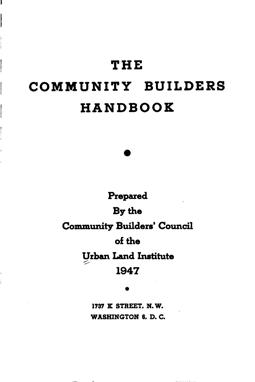
However, community builders also promoted and cemented racial exclusion and patterns of racial segregation in interwar and postwar suburbs. Perhaps the most well-known were the communities created exclusively for white veterans. The developers of the Levittown, the symbol of postwar suburbanization, “publicly and officially refused to sell to blacks for two decades after the war,” although the Levitts were “no more culpable in this regard than any other urban or suburban firm,” according to urban historian Kenneth Jackson (1985, 241). Decades later, Richard Rothstein (2017, 71) elaborated: The federal government played an instrumental role in institutionalizing racial exclusion in planned communities; the Federal Housing Administration (FHA) simply refused to secure loans for development without a commitment from the developers not to sell to Blacks.
The roots of racism in community building extend well beyond the postwar suburbs. As already mentioned, J.C. Nichols, a founding member of ULI, is largely deemed responsible for establishing racial exclusion as a prerequisite for successful community development (Gotham 2000). His 5,000-acre Kansas City Country Club District, begun in 1906, embodies the quintessential American suburb. With its curvilinear, tree-lined streets, and gracious middleclass homes set back from the street, the County Club District became “the place to live in Kansas City by 1930” (Jackson 1985, 176). Today it remains one of the most affluent, aesthetically pleasing, and desirable neighborhoods in Kansas City (Stevens n.d.).
Nichols’s communities constituted as much as 10 percent of Kansas City’s housing stock and all had racially restrictive covenants. This large footprint meant that Nichols’s communities effectively divided the city into two housing markets: “one for blacks and one for whites” (Stark 2020). Moreover, although Nichols was not the first to employ racially restrictive covenants, he is believed to be the inventor of the
8 Contents / Introduction Creating Diverse and Inclusive Communities
Title page of the 1947 edition of The Community Builders Handbook.
homeowners association (HOA), to renew and enforce the covenants in perpetuity (Stevens n.d.; Garvin 2002). This combination of restrictive covenants and HOAs spread rapidly among real estate industry professionals as the sure-fire formula for protecting home values and preserving the character of the community (Gotham 2000).

Nichols and the other community builders were also prominent members of the National Association of Real Estate Boards (NAREB) and wielded great influence on housing policies at all levels of government. Specifically, they lobbied for the creation of the FHA and worked as the agency’s advisers and consultants (Weiss 2002, 146, 157). The policies, standards, and regulations established in the early days of the FHA—such as the refusal to secure loans if Blacks were allowed to purchase homes—were informed by the successes of the developers such as Nichols. In this way, the U.S. government sponsored the creation of exclusive suburbs, influenced by community builders, which fueled white flight and exacerbated the deterioration of the urban core in the 1950s and the 1960s.
The New Communities Experiments of the 1960s and 1970s
In 1962, President John F. Kennedy issued an executive order to end the financing of residential segregation by federal agencies (Rothstein 2017, 177). However, the behaviors, norms, perceptions, and practices of community developers, homeowners, and financial institutions did not change overnight. Discrimination in housing and neighborhood choice can still be found well over 50 years after the passage of the Civil Rights Act.
But reason to hope remains. In contrast with the racially discriminatory practices of postwar suburbs, exemplary MPCs have also innovated and experimented with racial and class integration. Neighborhoods developed as part of the New Communities Program of the 1960s and 1970s embody the commitment to racial and class integration.3
The most well-known example of a deliberate effort to create an integrated community is James Rouse’s Columbia, Maryland, which he began developing in the early 1960s. The “Columbia concept” was to create a community truly integrated on a range of important social characteristics, such as class, age, family structure, housing tenure, ethnicity,
 Aerial image of the Kansas City Country Club District. (Google, ©2022 Maxar Technologies, U.S. Geological Survey, USDA/FPAC/GEO)
Sign for Kansas City Country Club District development, circa early 1900s. (State Historical Society of Missouri-Kansas City)
Aerial image of the Kansas City Country Club District. (Google, ©2022 Maxar Technologies, U.S. Geological Survey, USDA/FPAC/GEO)
Sign for Kansas City Country Club District development, circa early 1900s. (State Historical Society of Missouri-Kansas City)
9 Contents / Introduction Creating Diverse and Inclusive Communities
and race (Forsyth 2005, 115). This goal was to be implemented through several strategies. First was to offer diverse housing types. Second was being open to government-subsidized housing. Third was aggressive marketing aimed at Black populations.
Numerous scholarly and industry evaluations of the Columbia concept have been done; they largely agree that the experiment attained some of its goals, but fell short on others. Yuki Kato (2006) found that Columbia achieved fine-grained racial integration, which was a significant break with the dominant patterns of racial segregation in the region. In contrast, studies agree that Columbia has not been able to create economically diverse communities, having failed to create housing options for low-income households (Forsyth 2005). This shortcoming is not unique to Columbia. Developing new communities from scratch is an expensive endeavor not only because of the commitment to diversity and inclusion but also because these communities are trying to further goals such as sustainability and design excellence.
The Columbia concept was later transferred to The Woodlands in Texas. Developer George Mitchell was a contemporary of Rouse and was influenced both directly and indirectly by Columbia’s experience (Forsyth 2005). Although not as forthright and intentional about creating an integrated community, Mitchell also valued racially and economically integrated communities (Galatas and Barlow 2004, 116). For instance, he opposed the idea of gated communities (Forsyth 2005, 206).
For The Woodlands, the push for racial and class integration also came from the outside: The community was part of an institutionalized social experiment sponsored by the U.S. Department of Housing and Urban Development (HUD). Title IV of the 1968 Housing and Urban Development Act and Title VII of the 1970 New Community Development Act empowered HUD to select master-planned community development proposals to receive federal loan guarantees in return for meeting the standards
and expectations of creating better alternatives to urban sprawl; 12 communities were selected as a result (Burby and Weiss 1976). The Woodlands received $50 million and, as a condition, was required to set aside 17.3 percent of housing as affordable to low- and moderate-income households. The affordable housing stock was to be a combination of subsidized and inexpensive market-rate units (Forsyth 2005, 181). HUD also required that recipients conduct affirmative action plans (Galatas and Barlow 2004). Despite these incentives, The Woodlands has been less successful than Columbia, although better than generic suburbia (Forsyth 2005, 237).

10 Contents / Introduction Creating Diverse and Inclusive Communities
Plan for Columbia’s downtown. (Columbia Association)
The city of Irvine is another richly documented and studied new community of the era (Griffin 1974), but unlike the two examples discussed previously, Irvine was not driven by a strong vision of social equity (Forsyth 2005). Nonetheless, Irvine has grown into a more diverse community than much of suburbia (Kato 2006). This outcome stems primarily from a business decision made by the developer (Forsyth 2005, 78) as well as initiatives and policies of the city of Irvine (Forsyth 2005, 87–88). First, the developer realized that to capture a greater share of the market, it needed to provide a wide range of housing products that varied in both type and price. The result was elaborate market segmentation; the Woodbridge village, for example, provided a firm foundation for a more diverse population than subdivisions with a homogenous housing type (Forsyth 2005, 79–80). Second, the city increased its income-restricted affordable housing stock by collecting linkage fees from developers and using the fees to develop affordable housing. Likely as a result of these two factors, Irvine grew more diverse, both racially and economically, than typical suburban communities. It has been particularly popular among Asian populations.
Gated Communities and New Urbanism

While the New Communities experiment was sweeping the minds of policymakers and practitioners, an opposite trend emerged in the late 1960s. The concept of gated communities began to take off, a practice also invented and popularized by community developers. Retirement communities were the first places where average Americans could wall themselves off (Blakely and Snyder 1997, 4), but the concept spread rapidly beyond retirement communities and compounds for the super-rich (figure 4). From the 1970s through the 1990s, the majority of such communities were developed for the middle to upper-middle class. Given the market preference toward exclusivity, even visionary communities like The Woodlands and Columbia incorporated gated sections (Forsyth 2005).
The proliferation of gated communities shows how one form of exclusion can replace another. This trend was not entirely driven by race relations, but the urban riots and race war of the 1960s certainly motivated some homebuyers to seek gated communities. Homebuyers also cited aesthetic control, sense of order, and perception of prestige as reasons for seeking gated communities. Regardless, gates are a form and symbol of exclusion, an antithesis of diversity and inclusion.
In the late 1980s, the concept of new urbanism started to take hold in community development practice. The new urbanism movement carried forward the industry’s tradition of experimenting with and developing “better” communities. It also embraced diversity and inclusion, as evidenced by Article 13 of the Charter of the New Urbanism: “Within neighborhoods, a broad range of housing types and price levels can bring people of diverse ages, races, and incomes into daily interaction, strengthening the personal and civic bonds essential to an authentic community.”4 However, beyond stating this principle, new urbanist communities have been less ambitious and intentional about creating integrated communities than Columbia and other New Communities.
Figure 4. The Rise of Gated Communities in the United States
11 Contents / Introduction Creating Diverse and Inclusive Communities
Source: Reprinted from Blakely and Snyder (1997, fig. 1-2).
A frequent criticism of new urbanist communities and new urbanism concerns their tendency to create upper-middle-class communities that perpetuate segregation by class, race, and ethnicity (Ellis 2002). Empirical research largely confirms this criticism, though some studies disagree (Talen 2003). For example, Cabrera and Najarian (2013) explore whether new urbanist communities are more diverse than typical subdivisions; the authors find that they are more diverse at the community level but do not promote social interactions across different demographics at the micro level. Grant and Perrott (2009) examine a highly regarded new urbanist community in Ontario; they conclude that planning policies and regulations which call for diversity in housing types, land uses, and densities may contribute to a community’s vitality and economic health but may not produce social equity.

In one case, new urbanists did make a deliberate attempt to create diverse and inclusive communities. The HOPE VI program of the 1990s was designed to redevelop large-scale public housing projects into mixed-income communities, and it has succeeded
in some places: the Robert Taylor Homes in Chicago, North Beach Place in San Francisco, and Arthur Capper/Carrollsburg Redevelopment in Washington, D.C. On the one hand, the HOPE VI experiment offers important lessons for creating communities where different income levels and housing products are seamlessly integrated. On the other hand, the program has been criticized by both academics and practitioners for the involuntary relocation of public housing residents and their low rates of return (National Housing Law Project 2002); studies found that residents who were relocated to more affluent neighborhoods were not much better off in general (Goetz 2010) and had not gained economic wealth in particular (Popkin, Levy, and Buron 2009).
Beyond the HOPE VI projects, moreover, the goal of racial and class integration was rarely the focus of community development practice in the 1980s and 1990s. Of the 26 communities featured in the ULI publication, Great Planned Communities (Gause 2002), only one HOPE VI project was featured for creating a mixed-income community. Other communities were celebrated for design excellence, ecological and environmental sustainability, creating
12 Contents / Introduction Creating Diverse and Inclusive Communities
Seaside, Florida. (Steve Tiesdell Legacy Collection on Flickr)
high-density urban settings in suburban context, overcoming challenges of infill development, and successfully balancing various land uses. Little attention was given to creating diverse and inclusive communities.
Some jurisdictions impose inclusionary housing ordinances, a local government practice that requires developers to set aside a certain percentage of units as income-restricted units. When new urbanist communities have been subject to such ordinances, the resulting mixed-income and mixeduse communities have been highly successful, both economically and socially. Montgomery County, Maryland, is known for having one of the oldest and most exacting inclusionary housing ordinances; the King Farm development there complied with the ordinance: 12.5 percent of the units are incomerestricted, and they are seamlessly integrated and indistinguishable from market rate homes.
Trends and Innovations since the 1990s
Another ULI publication, Trends and Innovations in Master-Planned Communities (Schmitz and Bookout 1998), heralded important trends that are observable in present-day MPCs. For example, the authors suggested that MPC developers should shift their focus from hard infrastructure and amenities to soft program development. They also projected less focus on golf courses and more on open space design and programming. Both trends have manifested in contemporary MPCs and will be discussed later in this report.
Most directly relevant to this report, Schmitz and Bookout (1998, 4) shed light on the “radical changes in the homebuyer profile.” They point out that there is no longer a homogenous profile of first-time homebuyers as there was in previous decades. They discuss demographic trends—such as aging baby boomers, the rise of gen Xers, and dramatic increases in immigration—and note that “homebuilders should expect a more diverse consumer base.”
If community developers had fully embraced the authors’ foresight, a new chapter in community development might have unfolded. However, the 1990s and 2000s were a tumultuous time for the housing market and, by corollary, for MPCs. With inflation-adjusted real home prices falling during the 1990s, community developers had limited capacity for innovation and experimentation as their profit margin narrowed and sales velocity slowed down.
The housing market briefly recovered in the 2000s and developed into a bubble, only to have the bubble burst and the market crash in 2007. The recovery from the 2007–2008 Great Recession was slow, and community developers remained wary in the ensuing decade. Given the precarious housing market of this era, little innovation and advancement has been documented in MPC development practice.
Since the 1998 Trends and Innovations and 2002 Great Planned Communities, ULI has published just one other book on master-planned communities. Published in 2010, it memorializes the legacy of Chuck Cobb and focuses on the communities he developed (Platt 2011). There has been little systematic documentation and evaluation of MPCs developed in the 1990s and 2000s or the diversity and inclusiveness of those communities. This report aims to fill this gap.
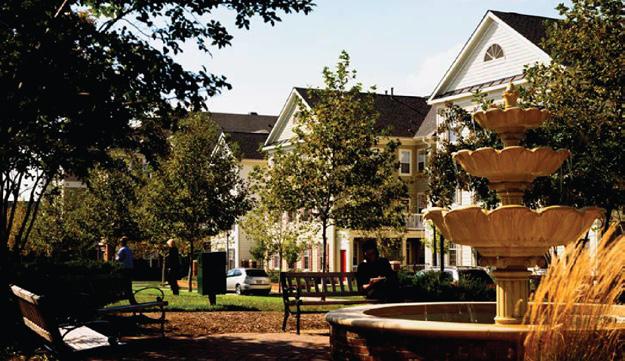
13 Contents / Introduction Creating Diverse and Inclusive Communities
Income-restricted units are seamlessly integrated in the King Farm development in Rockville, Maryland. (Torti Gallas + Partners)
The Business Case for Diversity
In stark contrast with the exclusionary history of community development practice, some contemporary MPC developers have started to embrace diversity as a core planning principle. Their commitment to diversity is not based purely on moral obligations.

In the words of one developer, Brent Gibadlo, senior vice president of Brookfield Properties, “Diversity is, first of all, good for business. . . . Diversity should be celebrated, and it won’t hurt your returns. . . . Your community will thrive more if it’s more diverse.” In other words, some community developers have come to embrace diversity because they believe that by creating diverse and inclusive communities, their business will also be more profitable and resilient.
Diversity makes development more financially successful for at least three reasons. First, diversity in housing product type creates a larger pool of potential homebuyers and renters. According to Jeremy Laster of Rancho Mission Viejo in California, “The more broad and diverse product types we can

offer, the [more] sales velocity goes up because we are addressing a larger market.” In contrast, if a community offers only detached single-family homes on almost identical lots, the range of incomes and lifestyles of homebuyers attracted to the community will be much narrower. Regardless of the size of the development company or its geographic location, the interviewed developers believed strongly in product diversification.
This need for housing product diversity was even advocated in the first edition of The Community Builder’s Handbook (Urban Land Institute 1947). The authors pointed out, “Better balanced residential communities and greater stability may often be obtained by having houses of various prices in a
15 Contents / The Business Case for Diversity Creating Diverse and Inclusive Communities
Potential homebuyers and renters at opening day of the Bridgeland development in Cypress, Texas. (The Howard Hughes Corporation)
single community.” They further noted, “A wellbalanced neighborhood plan containing a reasonable variation of housing accommodations will aid materially in stabilizing values and preventing decline by permitting the individual family to adjust its housing requirements to its age, marital status, and size at any given time and still remain within the community of its choice” (Urban Land Institute 1947, 57).
The second reason diversity can be good for business is that diverse housing product types and land use mix make the community more attractive to businesses. Among the studied communities, developers of those with exceptionally strong employment bases stated that employers are seeking communities with diverse land use and housing options. Gibadlo shared that when Nexton first opened in the mid 2010s, he and his team were keen on developing office buildings in a walkable, mixed-use location but did not see much interest from the office developers. Then, around 2015–2016, “it was almost like the switch flipped . . . [and] the office developers wanted to develop in a mixeduse environment.” This shift in attitude was largely driven by the need to attract and retain young talent. “The biggest thing for [the office] tenants was the ability to recruit and retain employees, and what they were seeing was that, particularly with millennials, employees value the quality of their work experience.”
The Tavistock Development Company had a similar experience at Lake Nona in Orlando and completely transformed its business practice in response to the employer and employee needs. Early in the community’s history, Tavistock sold large quantities of lots to homebuilders, a practice known as “bulk sales.” This strategy yields large sums of cash but inevitably leads to neighborhoods that are homogenous and often gated. However, as major medical institutions began moving to Lake Nona, Tavistock was pushed to change its business model. New visitors and prospective residents wanted to live in neighborhoods that were interesting and walkable and offered a wide range of housing products.
Responding to this demand, Tavistock now sells more than 80 percent of its homesites to builders in small chunks rather than using the bulk sales model of the past.
Third, diversity attracts new residents. In October 2021, a Wall Street Journal article reported increasing interest among both homebuyers and renters in living in a more diverse and inclusive community.5 Corroborating this penchant for diversity, the interviewed MPC developers shared concrete evidence that the demographic diversity of a community as well as the sense of openness to people from all walks of life have attracted new residents. For example, Cassie Cataline, director of marketing for Nexton/Brookfield Properties shared an interview with a recent homebuyer who commented, “The purposeful organization and development of the community was very important to us. Diversity in backgrounds, age, interests, vocations in the community also turned out to be important to us.”
Vicki Davis, a managing partner of Urban Atlantic and longstanding member of the ULI Terwilliger Center’s advisory board, has also witnessed this shift in consumer preference toward diverse neighborhoods in urban and inner-ring suburban markets. In upper northwest Washington, D.C., where the company is developing an affordable, 93-unit senior housing project, the median income of the census tract is around $350,000 per year. However, she sees strong support for income-restricted housing from residents of the community—which goes against the NIMBY (not in my backyard) narrative often found in wealthy neighborhoods. The company is also redeveloping the former Walter Reed Hospital site in D.C., a 67.5-acre site slated to have 2,400 housing units. The communities surrounding the project strongly demanded that income-restricted housing be integrated into the community, leading the company to set aside more than 20 percent of the units as affordable to families earning 50 percent of area median income or less.
16 Contents / The Business Case for Diversity Creating Diverse and Inclusive Communities
The diversity and openness of a community not only serves as a magnet that attracts the buyers and renters currently in the market, but also creates new demand. Developers reported that the current residents of these communities have been their most ardent marketers, encouraging families and friends to relocate. Such endorsement has been amplified when residents feel the community is truly diverse and inclusive.
Conversations with the developers of communities that are leading the industry suggest that an increasing number of developers are seeing diversity and inclusion as central to the financial success of their business. Having made a business case for creating diverse and inclusive communities, the rest of the report focuses on seven planning principles that can be adopted to establish the foundation of a diverse and inclusive community.

“In this supercharged political, antagonistic environment, having a place where people are different but can come together . . . is the key that makes a community stronger. Making the community stronger will encourage people to stay here . . . to bring their friends . . . to see if [they] are interested in moving to Lake Nona. And I think that is the gift that keeps giving. Truly, there is an economic benefit.”
—Craig Collin, Tavistock Development Company
17 Contents / The Business Case for Diversity Creating Diverse and Inclusive Communities
Family Fun Day, Lake Nona, Orlando. (Lake Nona Facebook page, reprinted with permission)
Seven Planning Principles for Creating Diverse and Inclusive Communities
The master-planned communities studied in this report boast vibrant community life, high levels of resident satisfaction, and exceptionally strong sales records. In-depth research into the secrets behind their successes reveals that these communities are undergirded by their commitment to diversity and inclusion. Seven principles, gleaned from the surveyed communities and from interviews, will help create the basic infrastructure/ foundation for creating diverse and inclusive communities.

1. Strive for a Diverse Land Use Mix
“You can create situations that are more or less equitable just by starting with your land use plan.”
—Chuck Smith of Preston Development Company, developer of Chatham Park
Diversity in land use mix can help promote diversity and inclusion in two ways. First, land use plans can integrate higher-density residential uses into traditional detached single-family neighborhoods. This way, developers encourage people with varied backgrounds and at different life stages to interact. This design also gives residents living in smaller units and rental properties access to higher-quality services and amenities.
Second, a good mix of retail, office, and light industrial uses better positions a community to
become more diverse in the long run. When new businesses representing a range of industries (health care, research, distribution, etc.) locate in a community, they draw in a correspondingly wide range of employees. To attract and retain such diverse talent, companies seek communities that offer a variety of land uses and housing options. In other words, a clear self-reinforcing mechanism is at play: diverse housing choices attract new businesses, which in turn attract a diverse employment base that will seek diverse housing choices.
The experiences of three communities—Lake Nona, Nexton, and Viera—demonstrate how diversity in land uses can encourage population diversity. All three communities have successfully attracted new jobs and people to the community, and each represents a different model for doing so. (See figure 5.)
Lake Nona Nexton Viera Acreage 10,800 5,000 43,000 Residential (single-family and multifamily units) 20,817 13,271 25,562 Retail (sq ft) 2,355,248 3,420,797 Office (sq ft) 8,516,689 5,800,000 2,825,490 Light industrial (sq ft) 14,110,989 582,156 Total nonresidential (sq ft) 24,982,926 5,800,000 6,828,443 Hotel rooms 3,658 542 951 19 Contents / Seven Planning Principles for Creating Diverse and Inclusive Communities Creating Diverse and Inclusive Communities
Figure 5. Land Use Breakdown of Selected Communities
Lake Nona
Lake Nona is a 10,800-acre MPC within a 15-minute drive of Orlando International Airport. Given its strategic location, the vision for Lake Nona has always been equal parts residential and nonresidential uses (see land use map). The first entitlement was secured in 1988: the 6,687 acres included approximately 1,900 acres of residential and 1,900 acres of nonresidential, with half of the latter designated for airport support use. The 2022 entitlement allows for 2,752 acres of residential, 1,041 acres of varied nonresidential uses, and 1,520 acres of airport support use.
However, according to Craig Collin, chief operating officer of the Tavistock Development Company, the evolution of Lake Nona took many unexpected turns, and the vision for the residential neighborhoods changed considerably. Initially, in the early 2000s, the plan was to sell land in large chunks to national homebuilders, but that plan did not materialize because of the 2007–2008 downturn. This failure turned out to be a blessing for the community.
At the height of the Great Recession, Sanford Burnham Research Institute decided to relocate from California to Lake Nona, enabled by financial subsidies provided by the state of Florida and Tavistock’s decision to offer land for free. Once Sanford decided to relocate, other medical institutions followed suit. The Veterans Administration Medical Center, Nemours Children’s Hospital, and University of Florida’s Research Center were among the early medical facilities to open in Lake Nona and helped the community earn the reputation of being a “medical city.”
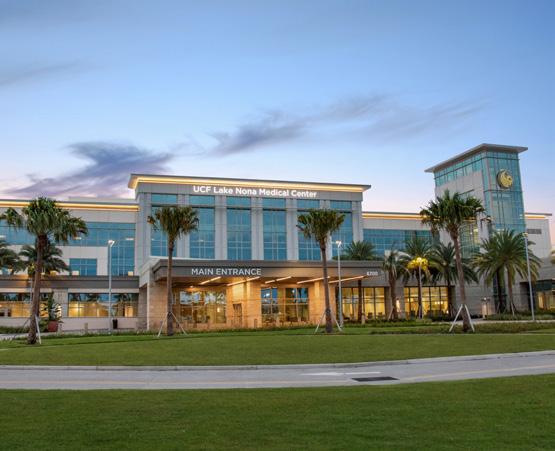
Nowadays, Lake Nona is emerging as a major employment center of the Orlando metropolitan statistical area (MSA) (see map and photos of employers). The community not only houses numerous medical facilities and university campuses but also diversified its commercial footprint by
 Lake Nona land use map. Yellow indicates residential use; purple, red, orange, and blue indicate nonresidential use. (Tavistock Development Company)
Lake Nona land use map. Yellow indicates residential use; purple, red, orange, and blue indicate nonresidential use. (Tavistock Development Company)
20 Contents / Seven Planning Principles for Creating Diverse and Inclusive Communities Creating Diverse and Inclusive Communities
University of Central Florida Lake Nona Medical Center facility. (Tavistock Development Company)
venturing into new industries, including sports and human performance. The U.S. Tennis Association is headquartered in Lake Nona as are Johnson and Johnson’s Human Performance Institute and KPMG’s Training Center.

The experience of Lake Nona illustrates the benefit of developing planned communities driven by employment growth. Rather than chasing homebuyers, Tavistock has been racing to meet the housing needs of the employees. And because the demographics of the potential homebuyers and renters were diverse to begin with, it was natural for Tavistock to embrace diversity in its master-planning and community development practice.
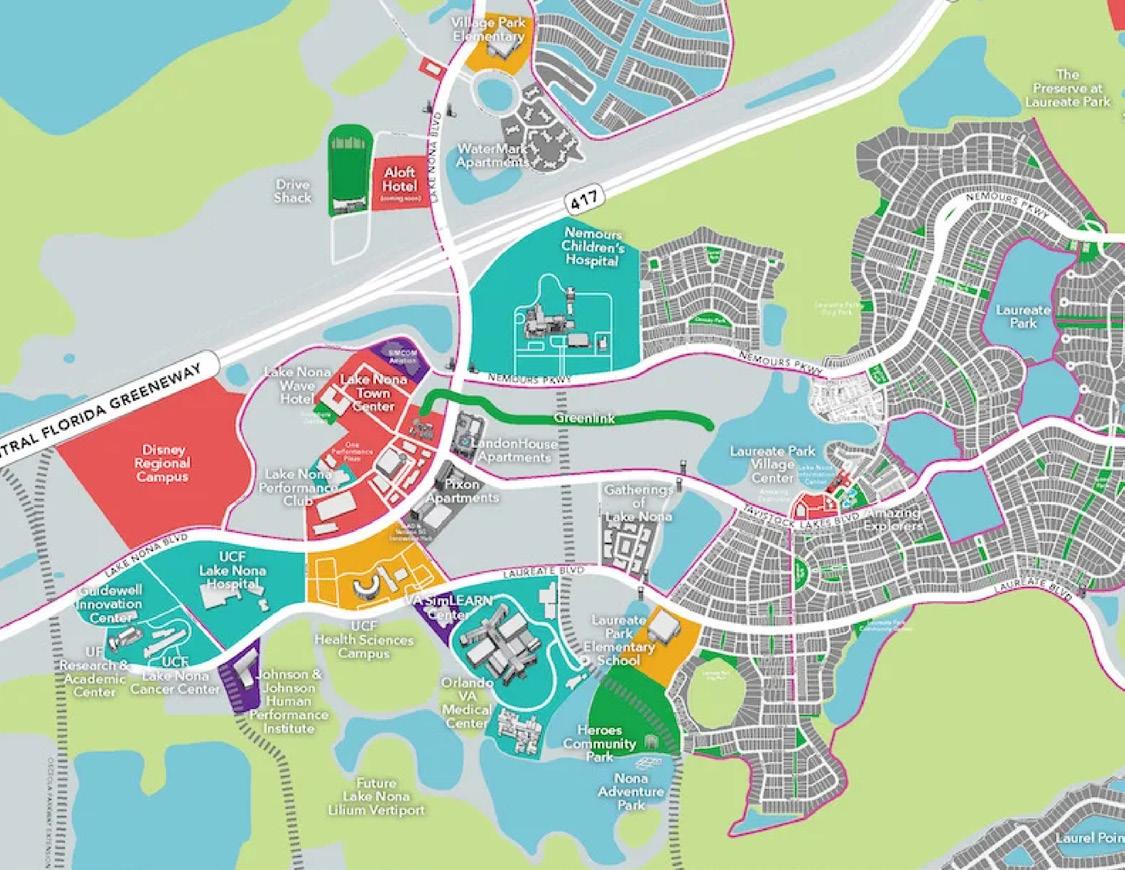
21 Contents / Seven Planning Principles for Creating Diverse and Inclusive Communities Creating Diverse and Inclusive Communities
Map of Lake Nona showing major employers. (Tavistock Development Company)
U.S. Tennis Association headquarters. (Tavistock Development Company)
Nexton
Nexton is a 5,000-acre community located near Charleston, South Carolina, and—like Lake Nona—its vision has always included a strong nonresidential component. The original developers recognized an untapped opportunity for Nexton to become a third employment center in the Charleston area. According to Brent Gibadlo, senior vice president of operations at Brookfield Properties, this vision was informed by extensive research and a holistic view of the growth trajectory of the region.
When Nexton’s planning team set out to establish its vision for the community, state and local officials were working to develop a large industrial cluster along the I-26 corridor. However, Charleston’s historic character meant there would not be much room for new office space in the downtown area. The region’s second employment center is the I-526 beltway surrounding Charleston, but most of that land had already been developed. Accordingly, the team saw the need to accommodate significant office development in the future and set out to make Nexton the third commercial hub of the region.
Nexton is located within a 25-minute drive to downtown Charleston, 15-minute drive to the Charleston International Airport, and 25-minute drive to the Port of Charleston (see area map). It also abuts the town of Summerville, a desirable residential area.

The planning team’s projections proved correct.
When Boeing decided to expand its office footprint, the company pushed out South Carolina Research Authority from its office space by the airport. After looking at 80 different sites, the Research Authority decided to move to Nexton. In 2015, Volvo broke ground on its first U.S. plant in Berkeley County where Nexton is also located. In 2018, MercedesBenz opened a new manufacturing plant, 10 minutes south. All these brought employment growth and created demand for both office and residential uses. Most recently, the Medical University of South Carolina has announced plans to build a second
hospital in Nexton. Grounded on a strong vision, Nexton is evolving into equal parts residential and commercial (see map of districts, following page).
Coupled with the goal of achieving diversity in land use types, Nexton’s plan also allows different intensities of residential uses to be placed near one another. This juxtaposition is possible because of an extremely flexible entitlement secured in 2015. Much of the site is zoned as “Village District,” which allows everything by right from detached single-family to multifamily on the residential side and conventional office, retail, restaurants and bars, and hotels on the commercial side. Educational institutions and assisted-living facilities are also allowed by right in the Village District. The only other developable zoning category within Nexton is “Rural Residential,” where only low-density detached single-family homes are permitted.
22 Contents / Seven Planning Principles for Creating Diverse and Inclusive Communities Creating Diverse and Inclusive Communities
Nexton regional map. (Brookfield Properties)
Nexton development program map. (Brookfield Properties)
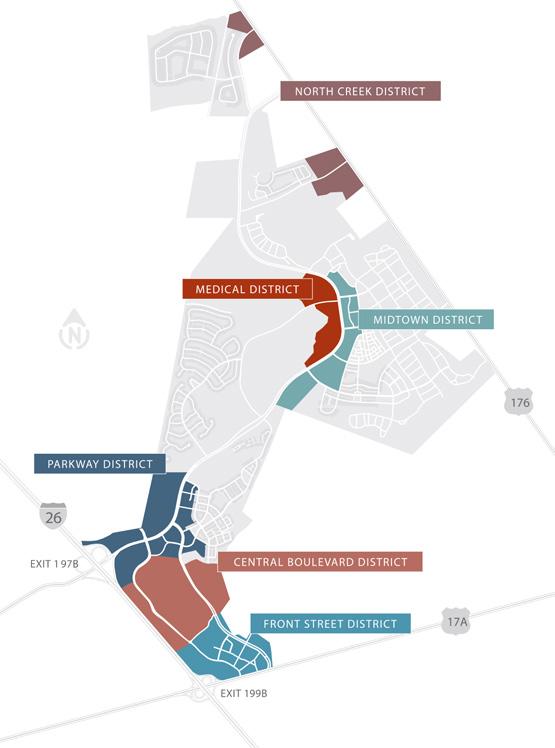
Nexton commercial land use map. (Brookfield Properties)
Examples of major employers in Nexton. (Brookfield Properties)
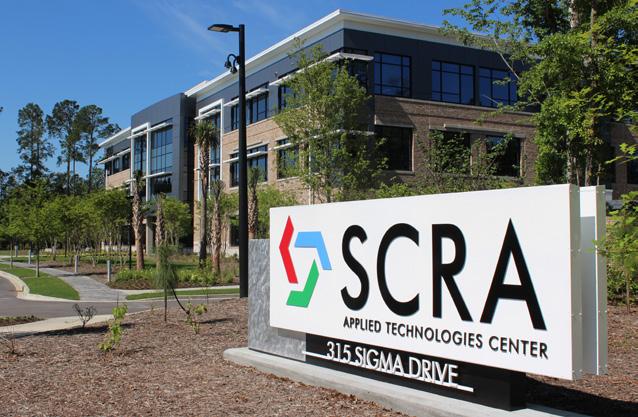
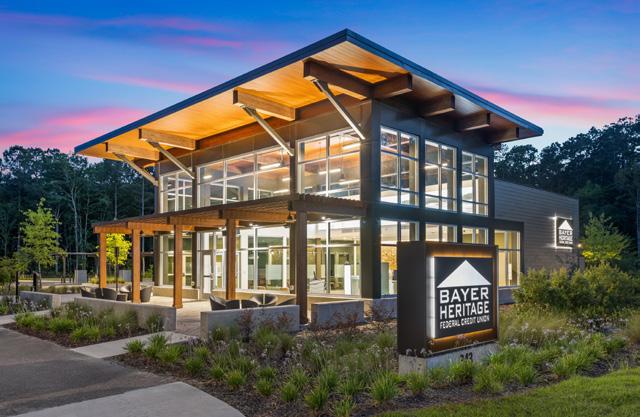
23 Contents / Seven Planning Principles for Creating Diverse and Inclusive Communities Creating Diverse and Inclusive Communities
DOWNTOWN SUMMERVILLE (5 MINUTES) B G O N PA K VD N X N P RKW NE TONPARKWAY NEXTONPARKWAY N X ON P RKWAY GRAN LVD NORTH CREEK VILLAGE MIDTOWN BRIGHTON P ARK NEXTON SQUARE NEXTON ELEMENTARY INFO COTTAGE TRUE HOMES CENTEX HOMES DOWNTOWN NEXTON ONE NEXTON MIDTOWN CLUB DEL WEBB NEXTON NORTH CREEK MARKETPLACE T CHARLESTON (25 MINUTES) P VOLVO EXIT 99B O 26 EXIT 97B 17A 176 MULTI-FAMILY / RENTAL APARTMENTS CURRENT DEVELOPMENT FUTURE DEVELOPMENT WOODLAND PRESERVE PARKS PONDS / LAKES
Viera
Viera is located east of Orlando, near Florida’s Space Coast. Viera’s strategy differs greatly from that of Lake Nona and Nexton as the community has always focused on residential development. Its initial vision was driven by the introduction of I-95 and the haphazard growth that came with the highway. Viera set out to become a residential hub that embodies the principles of smart growth, while conserving agricultural and environmentally sensitive land.

That vision began to shift as the first half of the community got built out. Todd Pokrywa, president of the Viera Company, recalled that when he joined the company in 2014, there was little room for new development without committing to mitigation measures for infrastructure and environmental impacts. The time was ripe to reassess the future development plans for Viera.
The community is located within a 30-minute drive of Florida’s Space Coast where NASA’s Kennedy Space Center and Cape Canaveral Space Force Station are located along with other major technology and aerospace brand names, such as Boeing, SpaceX, Raytheon, and Lockheed Martin. Rather than trying to land a tech giant of its own, Viera adopted the strategy of offering incredibly rich sports and recreational opportunities.
The new vision for growth emerged as a result of creative adaptation to challenging situations. Viera is home to the Space Coast Complex, which used to be the spring training grounds for several major league baseball teams. When the last major league team left the complex in 2015, the Viera Company worked with Brevard County to repurpose the facility for the U.S. Specialty Sports Association (USSSA). Then, building on the momentum started by USSSA, the county invested $5 million to develop Viera Regional Park, an 11-acre park with six softball and baseball fields, a t-ball field, and seven multipurpose fields.
24 Contents / Seven Planning Principles for Creating Diverse and Inclusive Communities Creating Diverse and Inclusive Communities
Location of the three town centers of Viera. (The Viera Company)
The case of Viera demonstrates how recreational uses and amenities can attract a diverse range of visitors and residents to planned communities. The two anchor recreational facilities have attracted people who might not otherwise have visited the Space Coast or Viera. USSSA runs more than 275 tournaments year-round; between the tournaments and Viera Regional Park, the estimated demand for hotel rooms is over 125,000 nights per year. Two hotels opened at the center of the community in response to the increased demand, prompting the company to conceptualize and promote three distinct mixed-use town centers, which had not been part of the original plan for the community. (See map and panorama.)
Lastly, one strategy Viera has used to attract commercial developers is to offer financial incentives. According to Dr. Hank Fishkind, an expert in the economics of real estate development and a consultant to many top-selling MPCs, almost all major MPCs are developed using a financing mechanism referred to as “district financing.”6 This model allows the developer to borrow large sums of money up front and pay back the bond holders later with a combination of payments made by the developer, homebuilders, homebuyers, and other commercial property holders. To attract commercial developers, Viera subsidized the debt burden borne by the commercial properties to make the development opportunity more financially appealing for office, retail, hotel, and industrial developers.
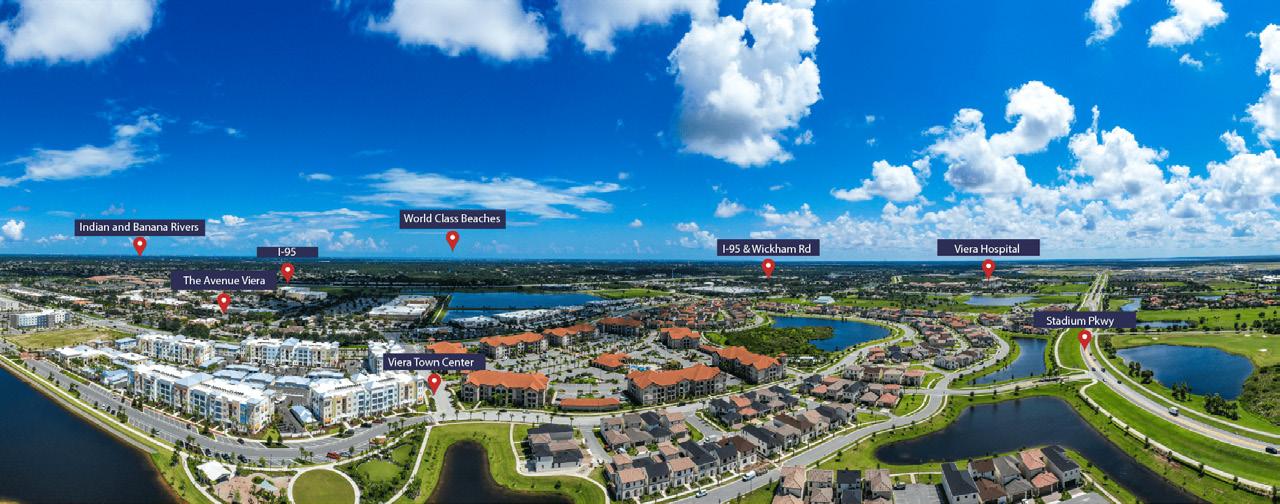
25 Contents / Seven Planning Principles for Creating Diverse and Inclusive Communities Creating Diverse and Inclusive Communities
Panoramic view of a town center in Viera. (The Viera Company)
Comparing the Three Communities
Figure 6 compares the demographic makeup of the three communities with the suburbs of the respective metropolitan area. Lake Nona is clearly less white than the rest of the Orlando suburbs; Nexton is a bit whiter than Charleston suburbs; Viera’s non-Hispanic white representation is approximately the same as the broader metro area’s suburban communities. All three communities have a greater representation of Hispanic, Asian, and mixed-race populations, a combination of which contribute to the percentage of non-Hispanic whites.
However, all three communities fall short when it comes to Black representation. This shortcoming
demonstrates the critical need to be more intentional and proactive about lowering barriers to planned communities. MPCs are typically priced higher than other residential subdivisions, and Black households are disproportionately represented in low-income households. Other deep structural issues that also contribute to the lower rates of Black homeownership in these communities are beyond the scope of MPC developers; these issues include unequal access to credit and the weaker ability to make downpayment (Stegman and Loftin 2021; McCargo, Choi, and Golding 2019).
Lake Orlando Charleston Palm Bay Nona suburbs Nexton suburbs Viera suburbs Non-Hispanic white 44.7% 48.0% 69.9% 63.0% 78.3% 77.7% Hispanic 37.8% 30.6% 6.7% 6.1% 9.1% 8.7% Black 3.7% 14.1% 11.3% 25.8% 4.0% 7.5% Asian and Pacific Islander 8.0% 4.3% 5.1% 1.8% 3.6% 2.6% Some other race alone 1.0% 0.9% 0.9% 0.6% 1.0% 0.5% Two or more races 4.7% 2.1% 6.0% 2.7% 4.1% 3.0% Source: 2020 U.S. census. 26 Contents / Seven Planning Principles for Creating Diverse and Inclusive Communities Creating Diverse and Inclusive Communities
Figure 6. Demographic Composition of Selected Communities
2. Diversify Housing Choice
Offering diverse housing types, tenure, sizes, styles, and price range creates a firm foundation for accommodating a wide range of living arrangements, family configurations, income levels, lifestyles, and culture. Therefore, MPC developers have a long history of experimenting with housing product diversification, more commonly known as product “segmentation” among industry professionals. Applications of this tradition are found in the pioneering towns of Columbia, The Woodlands, and Irvine (already described), a practice driven by both economics and ideology (Forsyth 2005). By diversifying housing options, developers hope to capture a larger share of the market, allowing them to sell more homes at a faster pace. In Columbia and The Woodlands, the developers also hoped to create a socioeconomically integrated community.
As discussed earlier, the idea that diversity in housing choice will lead to a diverse community can be traced back to the “Columbia concept” developed during the planning and design stages of Columbia (Forsyth 2005, 120–123). James Rouse, the visionary developer behind Columbia, strove to create a racially and economically integrated community. One of his core strategies was to diversify housing choice, not only within the community as a whole, but also within individual villages and neighborhoods, subunits of the community.

Many of Columbia’s planning concepts were then transferred to The Woodlands. The image on this page illustrates the mixture of housing product types available in the village of Alden Bridge, one of the many villages in The Woodlands, which opened in 1994. The Village Center, with its neighborhood retail shops, functions as the focal point of the village. Within walking distance of the Village Center are attached townhouses as well as garden-style apartments and condominiums. A senior-care facility is also located at the heart of the village. Detached single-family enclaves with varying densities surround the Village Center.
However, socioeconomic and racial diversity cannot be achieved simply by diversifying housing product types. In Columbia, the effort to create an integrated community was backed by other strategies, such as aggressive marketing to diverse racial groups and the integration of subsidized housing. As a result, Columbia was able to achieve a fine-grained racial integration in a highly segregated region, according to Yuki Kato’s (2006) analysis of Columbia, The Woodlands, and Irvine using 2000 Census data. The Woodlands, by contrast, was less diverse than the region, with a significant underrepresentation of the Black population in particular. Such a difference indicates the importance of establishing a multipronged approach to creating diverse and inclusive communities.
Kato also concluded that despite its multipronged approach, Columbia was not very successful in achieving economic integration; nor did the other two communities fare much better. This finding points to
27 Contents / Seven Planning Principles for Creating Diverse and Inclusive Communities Creating Diverse and Inclusive Communities
Aerial photograph of the homes in and around the Village Center in Alden Bridge, The Woodlands. (Google, ©2022 Maxar Technologies, U.S. Geological Survey, USDA/FPAC/GEO)
the difficulty in making housing attainable to lowerincome households, even if there is goodwill from the development team. And because lower-income households are disproportionately represented by households of color, economic integration should be the building block for social and racial integration. Therefore, the next section of this report focuses specifically on attainability challenges and possible ways to tackle the issue.
Lastly, for smaller communities and those located in tertiary markets, diversifying housing products to any great extent may not be feasible as developers typically have less control over builders under such conditions. Community developers may have to sell lots in big chunks (“bulk sales”) with little control over what gets built on those lots. And builders are reluctant to introduce specialty products if they do not have a strong pipeline of detached single-family homes, especially if they are operating in tertiary markets where the sales volume and velocity cannot be guaranteed. Under these circumstances, the best
strategy is to develop a close working relationship with the builders who are more open to new ideas and willing to test innovative products.
How Diverse Are Housing Products in MPCs?
Building and selling detached single-family houses is the bread and butter of the MPC development business. However, the survey results reveal that 20 out of 29 communities also offer additional housing options. Among the nine communities that offer only single-family homes, six reported plans to diversify their product offerings (figure 7).
The most common for-sale alternative was multiplex/townhouses for sale. Interviewed developers reported that for sale townhouses are a convenient, comparable, and attainable alternative to detached single-family homes, attractive to young families and empty nesters. Townhouses provide the stability of owning a home without the trouble

28 Contents / Seven Planning Principles for Creating Diverse and Inclusive Communities Creating Diverse and Inclusive Communities
Figure 7. For-Sale Product Type Diversity
of landscaping and other maintenance issues that come with detached homes. Townhouses are also generally more attainable.
Many communities also offer other “missing middle housing,” a term coined by Opticos Design, a California-based urban design and architecture firm.7 It refers to all housing product types that sit between detached single-family homes and mid-rise multifamily apartments. These include duplexes, triplexes, fourplexes, multiplexes, townhouses, and detached single-family homes that are organized around a courtyard, sharing one large lot, instead of owning individual lots. Among the 29 surveyed communities, 17 offer townhouses, 15 offer duplexes, and eight offer low-rise garden-style condos. While
not captured in the survey, some communities also offer multiplexes and cluster homes oriented around a courtyard.
Product diversification has been taken to the next level at Lake Nona in Orlando. Laureate Park in Lake Nona, for example, has not only detached singlefamily homes and attached townhouses, but also other missing middle homes, such as duplexes and fourplexes. Moreover, rather than grouping each product type separately, which creates little enclaves of specialty products, the products are interspersed throughout the neighborhood. This approach stands out from the typical product segmentation strategy. Developers may offer diverse product types within a village but tend to cluster the same product types,

29 Contents / Seven Planning Principles for Creating Diverse and Inclusive Communities Creating Diverse and Inclusive Communities
Lake Nona Laureate Park product types. (Graphic created by author. Aerial image: Google, ©2022 Maxar Technologies, U.S. Geological Survey, Map data ©2022. Other images: Minjee Kim; Tavistock Development Company)
creating a relatively homogenous experience at the neighborhood level. Adam Ducker, CEO of RCLCO, referred to such practice as “micro-segmentation” to differentiate the practice from conventional segmentation strategies.
Another surveyed community is Lakewood Ranch, Florida. Waterside Place is its newest village and offers a wide range of housing options, including detached single-family homes, duplexes, townhouses for sale and for rent, mid-rise apartments, senior living facilities, and single-family homes built for rent. (See maps of area and product mix.) What is unique about Waterside Place is that, in two of its neighborhoods, 40 percent of the homes will be income-restricted to meet Sarasota County’s inclusionary housing ordinance. That means households earning between 80 and 120 percent of area median income (AMI) will be eligible for these units.
30 Contents / Seven Planning Principles for Creating Diverse and Inclusive Communities Creating Diverse and Inclusive Communities
“In Waterside, we have 10 neighborhoods connected by trails and waterways to our new town center, offering a wide variety of homes, including single-family rentals, apartments, a senior living campus, townhomes, cottages, and custom homes. Nearly 40 percent of the homes [in two of the neighborhoods] will be attainable to households making 80 percent to 120 percent of AMI, and these are integrated with market-rate and custom home programs selling well in excess of $2 million.”
—Laura Cole, Lakewood Ranch
WHITE EAGLE BLVD. STATE ROAD 70 STATE ROAD 70 59TH STATE ROAD 64 UNIVERSITY PARKWAY DEER DRIVE LEGACY BLVD. LORRAINE ROAD LAKE OSPREYDR. THEMASTERSAVENUE N NTWAY LAKECLUBBLVD. COMMUNICATIONS PARKWAY A W O NA H D O N RETNEC KR A H D EN TRAL A EN EA T W H D WH E LORRAINE ROAD LORRAINE ROAD A W O DO N H BLVD BRADEN RIVER BRADEN RIVER WOODFERNTRA O BLV UIHLEIN RD PROFE IONA P RK AY PRO E SONAL P R KINGFISHER LAKE LAKE S T MA DR VE LAKEWOOD R C D STATE ROAD 64 BOURNESIDE BLVD OU N D B D UNIVERSITY PARKWAY G DR FRUITVILLE ROAD LORRAINE ROAD LAKEWOOD RANCH BLVD. UIHLEIN RD RANG PKW BLVD. L 75 75 75 TO 75 TO Information Schools Higher Parks Trails Hospitals Post Offices Fire Government Buildings RENTAL PROPERTIES Hotels Golf Shopping Senior LIVING Cricket Athletic ACTIVELY SELLING TOWN CenterS LIBRARY FUTURE Sold OUT Polo Run Riverwalk The Country Club Edgewater Waterfront Corporate Park Sarasota Polo Ranches Greenbrook Palisades Bridgewater Esplanade Golf & Country Club Central Park MALLORY PARK ARBOR GRANDE Commerce Park Business Park Heritage Ranch Conservation Easement Country Club East Shoreview Cove (EARLY 2023) (2023) LAKESHORE (2023 Waterside RESIDENTIAL (FUTURE) AVALON WOODS (FALL 202 RESIDENTIAL (FUTURE) The Lake Club The Isles Del Webb LAKEWOOD NATIONAL GOLF CLUB Sapphire point Cresswind LorrAINE LAKES Solera SWEETWATER AZARIO Esplanade PARK EAST STAR FARMS WOODLEAF HAMMOCK Indigo SAVANNA Summerfield Harmony Waterside WINDWARD Sarasota Polo Club Ritz-Carlton Members Golf Club (FUTURE) Heron’s Nest Nature Park Country Club Park Tennis Athletic Center Royal Lakes Golf Course King’s Dunes Golf Course Legacy Public Golf Course Golf Course w R MAIN CLUBHOUSE ew Manatee Chamber Town Hall NORTH The Venue Apartments BREA Apartments (SPRING 2022) ANTIGUA (SUMMER 2023) RESIDENCES AT THE GREEN Apartments Even Hotel Creekside Apartments VIDA APARTMENTS (FALL 2022) ARTESIA Lakewood Ranch OASIS ON MANATEE RIVER (FALL 2022) BOTANIC Apartments WATERSIDE PLACE TOWNHOMES SHERIDAN CYPRESS SPRINGS GRACIOUS RETIREMENT LIVING WINDSOR REFLECTIONS GRAND LIVING Apartments Fairfield Inn HYATT PLACE (FUTURE) Lakewood Ranch Main Street UNIVERSITY CORNER Shoppes At Summerfield Lorraine Corners Gateway White Eagle Plaza Braden River Information Center Premier Sports Campus LIBRARY (FUTURE)
Waterside Place within Lakewood Ranch, Florida. (SchroederManatee Ranch)
Housing and care options for the elderly is another specialty product type found in the surveyed communities. Laura Cole, senior vice president of Lakewood Ranch, anticipates a huge deficit in housing and care for the elderly. In response, Lakewood Ranch is planning to build a Continued Care Retirement Campus (1,200 units) in addition to the existing four senior-living facilities. A second hospital will also be constructed. Reflecting this growing need for senior care, five of the surveyed communities have plans to either introduce or expand assisted-living facilities.
Rental Options
Rental properties are becoming an integral part of master-planned communities. Twelve of 29 surveyed communities have multifamily rental properties; six offer townhouse rentals; four have singlefamily rental enclaves; nine offer low-rise, gardenstyle apartments; one offers high-rise multifamily apartments. Eleven of the communities offer more than one type of rental product. And many are considering adding more rental products (see figure 8). Detached single-family homes intentionally built for rent will be discussed in the subsequent section.
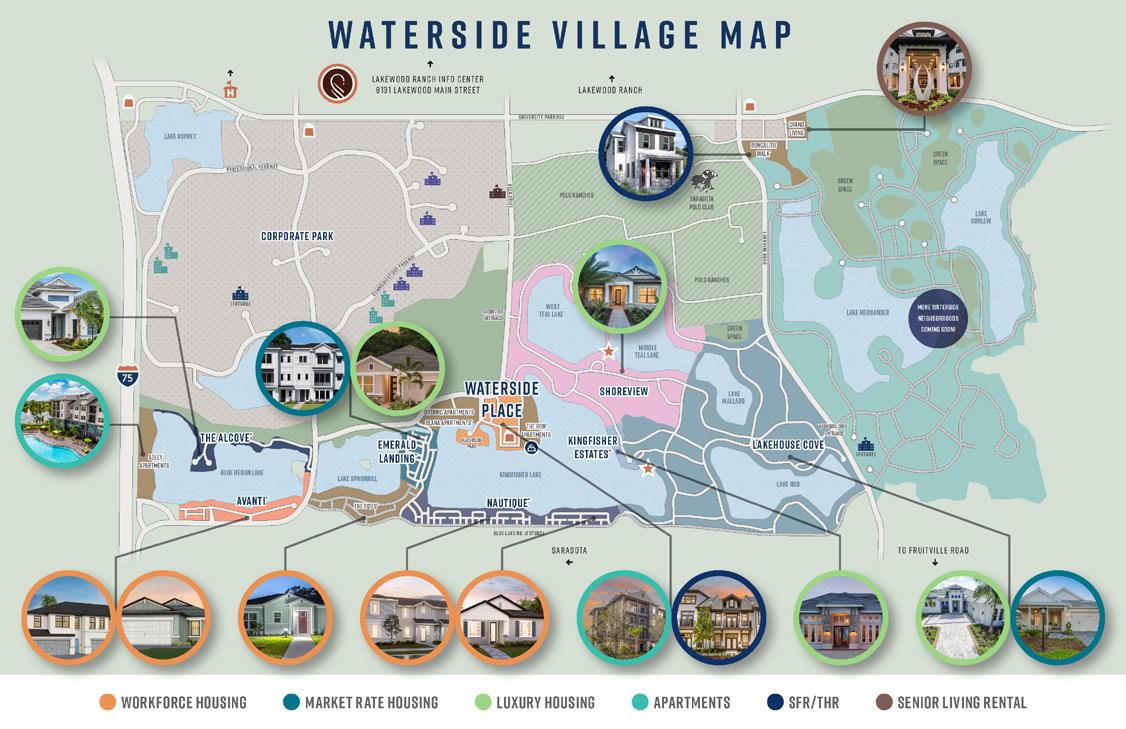
31 Contents / Seven Planning Principles for Creating Diverse and Inclusive Communities Creating Diverse and Inclusive Communities
The diverse housing options available in Waterside, in Lakewood Ranch, Florida. (Schroeder-Manatee Ranch)
Interviewed developers believe the strategic location of rental properties determines the success of the rental product. Mid-rise and high-rise apartments are deemed most suitable in town centers where jobs are located within walking or biking distance and where retail shops and restaurants are typically found. For example, the town center of Lake Nona is home to multiple medical institutions and other major employers. Lake Nona takes advantage of this strong employment base (some employees may live in the community for only a few months, some for several years) by offering both high-rise and mid-rise apartment options in the town center.
Mid-rise apartments and single-family homes built for rent are also suitable in and around town and village centers. Experts agree households drawn to
these product types are willing to sacrifice the sizes of homes and lawns if they can be within proximity to retail shops and indoor and outdoor amenities. Only a couple communities have successfully introduced apartments above ground-floor retail in town centers, mainly because of financing challenges. Developers reported that lenders were hesitant to finance vertically mixed-used buildings in MPCs. The two projects that were able to include such products were self-financed.

More modest mid-rise and garden-style apartments are sometimes built near highways, where they have good transportation access and are not near singlefamily neighborhoods. Developers reported facing NIMBY sentiment when they propose attainable

32 Contents / Seven Planning Principles for Creating Diverse and Inclusive Communities Creating Diverse and Inclusive Communities
Figure 8. Rental Product Type Diversity
multifamily rental projects; by placing them on commercial sites and near highways, developers face less resistance from existing residents. This experience demonstrates there is room for improvement even among the most innovative and progressive community development practitioners. Placing more attainable products in less desirable locations, particularly along highways, repeats the practice of relegating lower-income neighborhoods to unhealthy and dangerous parts of cities and towns.
In terms of the development and long-term ownership of rental properties, strategies of the community developers vary. Some develop their own rental
properties in partnerships with apartment developers and hold them as a long-term asset, others simply sell lots to apartment developers. However, even when selling lots, the community developer works closely with the apartment developers to ensure they meet the regulations and expectations of the broader community.
The conventional wisdom is that renting is more affordable than owning a house. Therefore, to understand whether rental properties are, in fact, lowering the entry barriers to MPCs, rents for two-bedroom apartments were compared with

33 Contents / Seven Planning Principles for Creating Diverse and Inclusive Communities Creating Diverse and Inclusive Communities
Lake Nona rental product diversity in the town center. (Graphic created by the author. Aerial image: Google, ©2022 Maxar Technologies, U.S. Geological Survey, Map data ©2022. Other images: Minjee Kim; Tavistock Development Company)
the monthly cost of homeownership of the most attainable product line.
Figure 9 shows the monthly cost of homeownership, accounting for the actual HOA fees and monthly taxes, and compares these data points with rents for a two-bedroom apartment. Applicable HOA fees were identified from the information available on the community web pages; monthly taxes were drawn from property tax records of the actual homes in the community.
There are two important takeaways from this comparison. First, rental options in MPCs are clearly lowering the entry barriers to these communities. Second, the cost of housing, both for sale and for rent, are extremely high. A two-bedroom apartment and the attainable product lines are appropriate housing options for families of three. To comfortably afford the rental option, families would have to earn above $81,000 per year. To consider buying the most attainable product line, families would have to earn above $133,000 per year, an income level above that of most Americans—even on a dual income stream.
Metro area Community Sales price of most attainable new construction Applicable HOA dues Monthly tax Monthly cost of homeownership Rent for two-bedroom apartment 34 Contents / Seven Planning Principles for Creating Diverse and Inclusive Communities Creating Diverse and Inclusive Communities
Figure 9. Comparison of Monthly Cost of Homeownership versus Monthly Rent
Phoenix Verrado $630,000 $112 $225 $4,542 $2,250 Phoenix Eastmark $418,528 $146 $216 $3,659 $1,940 South Orange Rancho $475,000 $400 $792 $4,731 $3,000 County Mission Viejo Jacksonville Nocatee $470,000 $146 $500 $4,164 $2,200 Tampa FishHawk $400,500 $150 $529 $3,898 $3,000 Ranch North Port- Lakewood Bradenton- Ranch $351,000 $300 $579 $3,886 $2,327 Sarasota Orlando Lake Nona $360,000 $350 $600 $3,996 $2,450 Palm BayMelbourne- Viera $337,500 $306 $367 $3,622 $2,186 Titusville Atlanta Serenbe $710,000 $154 $672 $5,375 $3,300 Las Vegas Summerlin $477,990 $140 $210 $3,902 $2,075 Wilmington Riverlights $390,000 $100 $268 $3,542 $1,840 Raleigh Wendell Falls $375,000 $100 $313 $3,523 $1,662 Portland Reed’s $387,000 $265 $319 $3,746 $2,219 Crossing Charleston Nexton $340,000 $50 $408 $3,418 $2,200 Houston Bridgeland $372,000 $196 $612 $3,905 $2,900
Adding a Built-for-Rent Option
Acknowledging the “exponential interest and growth” in purpose-built single-family rental housing (commonly referred to as built-for-rent, or BFR), the ULI Terwilliger Center for Housing partnered with RCLCO to document the trends in BFR development, investment, and management practices in Low-Density Rental Housing in America (Bacalao et al. 2021). MPCs are no exception to this rising prominence of BFR communities. Of the 29 communities surveyed, four already have BFR enclaves and nine more plan to introduce the product type in the future.
The conventional wisdom says that BFR homes are homogenous, corporate-managed investment products. To the contrary, those located within well-designed MPCs are often integrated with the broader community and offer a high-quality living experience without the burden of buying a house. Dan Kelly of DMB Associates, the company behind nationally acclaimed communities such as Eastmark and Verrado, believes there is a clear advantage in incorporating BFR housing in MPCs. Kelly notes that community developers push for good design, highquality outdoor space, a robust health care network, and great schools. Access to such amenities on a day-to-day basis, without having to make a life decision to purchase a home in that community, is an extremely attractive option.
However, Kelly also notes that including BFR enclaves in MPCs is not easy given the high cost of land and higher standard for design and aesthetic controls. He recommends that master developers partnering with BFR developers carefully consider several factors: where the BFR enclave will be located within the community, the corresponding rents that can be achieved, and whether BFR residents will have access to the broader community’s amenities. These factors together should inform the negotiated purchase price of land as well as the level of design scrutiny that can be realistically imposed on the property. Illustratively, Verrado currently has two BFR
projects underway, and the price-per-square-foot of land is almost twice as much for the site located within walking distance of town center amenities as for the site located by the highway.
ULI’s report, Low-Density Rental Housing (Bacalao et al. 2021), identifies three distinct types of BFR communities: (1) horizontal apartments, (2) singlefamily attached, and (3) single-family detached. All three types can be found in the surveyed communities.
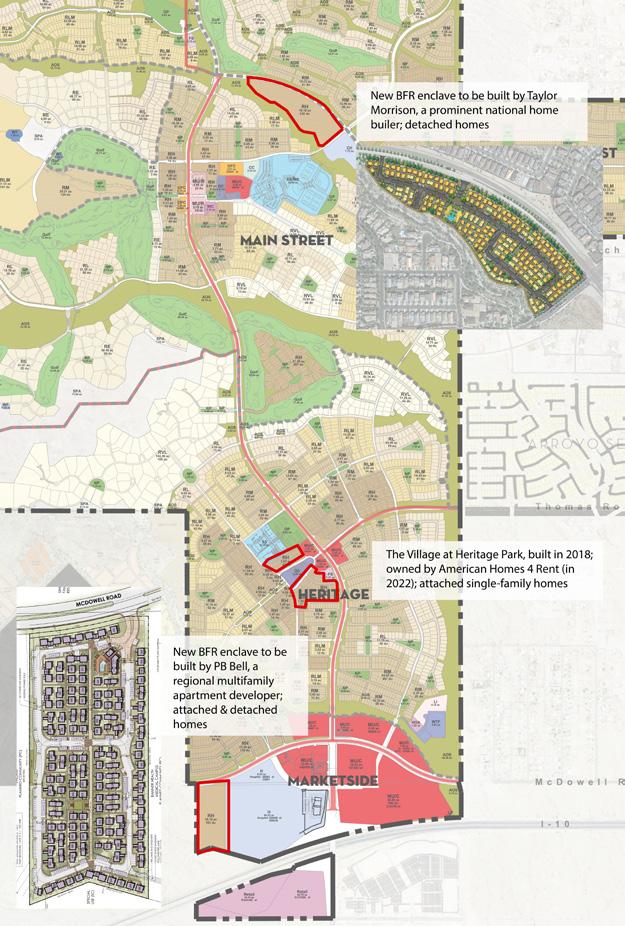
35 Contents / Seven Planning Principles for Creating Diverse and Inclusive Communities Creating Diverse and Inclusive Communities
Locations of three BFR communities in Verrado (Arizona). (Graphic created by the author. Image: DMB Associates)
New BFR enclave to be built by Taylor Morrison, a prominent national home builder; detached homes
New BFR enclave to be built by PB Bell, a regional multifamily apartment developer; attached and detached homes
The Village at Heritage Park, built in 2018; owned by American Homes 4 Rent (in 2022); attached single-family homes
Estia at Lakewood Ranch is one of the most expensive BFR enclaves in the surveyed communities. It can be classified as “horizontal apartment”–style BFR and “self-amenitized”—that is, the enclave has its own amenities. Commanding rents above $3 per square foot, these one-to-two-bedroom apartments range from the low $2,000s to low $3,000s per month. Laura Cole of Lakewood Ranch notes the greatest demand for BFR options comes from single parents and empty nesters. The property has been extremely successful, and the rents are relatively more attainable when compared with the average sales price of a newly constructed home in Lakewood Ranch, which is closer to $800,000. However, the

rents are cost prohibitive, particularly for families in need of space. To counter this attainability challenge, Lakewood Ranch will be introducing a BFR enclave, The Tides, which will offer 366 income-restricted units as part of an agreement with Sarasota County.
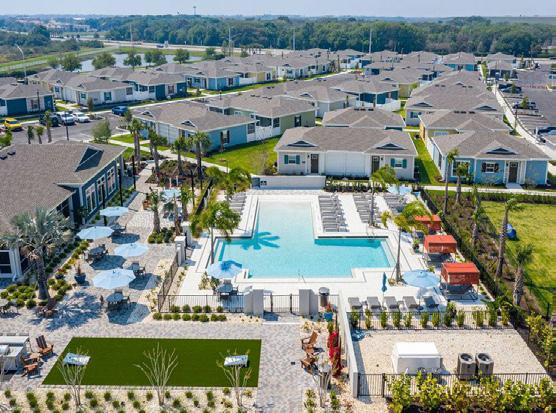
When rents are lower, BFR enclaves can be familyfriendly and attract younger residents, such as young millennial families, families waiting for their homes to be built, singles without partners, and couples without kids. The Villas at Nexton is a single-family detached BFR community, built at the density of 11 units per acre. Instead of building nearly identical one-story houses with very little space in between, the Villas offers homes that have more character, privacy, and space. The cottage-style houses have one to three bedrooms with lower rents per square foot, ranging from $1.95 to $2.65 per square foot. The architecture of the homes is also more varied, providing the experience of living in a singlefamily detached home rather than an apartment. Other Brookfield Properties communities, such as Riverlights in North Carolina, have also started to introduce the same BFR model.
One way to bring down the rents of BFR products is to build attached single-family homes, such as townhouses, rather than detached houses. Rancho Sahuarita in Tucson, Arizona, has always focused on meeting the housing needs of families earning at or around the median income. When they decided to offer a BFR option, the development team realized that a detached BFR enclave would be out of reach for most families in the region. Accordingly, they have switched gears to offer an attached for-rent townhouse product and aim to achieve rents below $1 per square foot.
DMB Associates has long experience with BFR in planned communities. In 2018, it completed the Village at Heritage Park in Verrado (Arizona) as attached two-story townhouses for rent. The project was originally developed by B&B Living, one of the first companies in the BFR market, and now is
36 Contents / Seven Planning Principles for Creating Diverse and Inclusive Communities Creating Diverse and Inclusive Communities
Estia at Lakewood Ranch plan. (Schroeder-Manatee Ranch)
Estia at Lakewood Ranch. (Schroeder-Manatee Ranch)
owned by American Homes 4 Rent, a publicly traded real estate investment trust that invests in BFR. The enclave is not closed off on its own, but rather is part of the larger community fabric and has no amenities of its own. The attached product type and not having separate amenities have allowed the rents to stay affordable, around $1.06 to $1.17 per square foot. However, Dan Kelly cautions that community developers should work very closely with the developers on aesthetics, as these properties may not fit well with the architectural character of the rest of the community.
The ULI report identifies several common criticisms of the BFR product. One such critique is that institutional investors are buying up older housing stock, taking it out of the housing market, and thereby exacerbating the housing affordability crisis. BFR units in MPCs, however, take on a completely different role. These enclaves lower the entry bar to MPCs, which are typically priced higher than the rest of the metro area due to the higher-quality amenities and infrastructure costs.


Another common critique is that the expansion of low-density rental housing could be pushing entrylevel housing further away from employment centers and adding more pressure to the environment and infrastructure needs. Here again, BFR units built in the context of MPCs are exceptions. They are less likely to negatively affect the environment and infrastructure needs if they are part of comprehensively planned communities that have preconceived their infrastructure needs and appropriately mitigated their environmental impacts.
BFR, in fact, has an edge in adding more rental stock to MPCs. Bill Meyer, regional president of Brookfield Properties, and formerly of Newland, shared that MPC residents often express NIMBY sentiment toward multifamily projects even though higherdensity housing was always part of the master plan. Given that single-family BFR renters tend to be long-term renters and the architectural character of BFR enclaves resemble single-family neighborhoods, Meyer anticipates less pushback from existing community residents as MPC developers look to add BFR enclaves in their communities.
37 Contents / Seven Planning Principles for Creating Diverse and Inclusive Communities Creating Diverse and Inclusive Communities
The Villas at Nexton site plan. (Brookfield Properties)
The Villas at Nexton. (Brookfield Properties)
3. Focus on Attainability
Master-planned communities often boast good schools, excellent amenities, safe neighborhoods, and a well-defined sense of community. These qualities make them high-opportunity neighborhoods, which can be understood as communities that offer ample opportunities for upward mobility, wealth generation, and healthy living. Therefore, when housing costs can be lowered in MPCs, entry barriers to high-opportunity neighborhoods are effectively being lowered, opening up the community to a wider range of income groups who will be able to enjoy higher levels of education and quality of life.
Some of the developers interviewed were clearly aware of the important contributions they could make in offering access to high-opportunity neighborhoods. “We believed wholeheartedly, if these kids didn’t live in our community, they probably wouldn’t be going to the best schools, they wouldn’t have the same experience,” remarked Jeremy Sharpe of Sharpe and Associates, the development team behind Rancho Sahuarita in Arizona. Sharpe and Associates concentrates its energy on bringing down the cost of housing as much as possible and has successfully kept prices attainable to households earning the Tucson average AMI. Demonstrating its commitment to housing attainability, Sharpe
and Associates was the primary sponsor of ULI Terwilliger Center’s 2019 report, Attainable Housing: Challenges, Perceptions, and Solutions (Ducker, Mangold, and Lynn 2019).
Nevertheless, even if the development team has the best intentions, homes in MPCs are going to be more expensive than those that are not a part of planned communities. The cost of infrastructure, amenities and programming, and maintenance are much higher in MPCs. These additional costs are absorbed initially by the builders when they purchase lots at a higher price, and then they push up the final sales prices of the homes. The costs are also transferred to homebuyers in the form of higher taxes. In many of the communities studied in this report, the resale market seems to be serving as the entry point for first-time homebuyers, which will be discussed in the following section. Making homes in MPCs as attainable as possible is a necessary condition for diversifying the demographic makeup of the communities.
Home Price Range
Figure 10 illustrates the attainability of the surveyed communities. All data points represent figures collected at the time the survey was administered
Note: MSA median includes both new and existing homes.

38 Contents / Seven Planning Principles for Creating Diverse and Inclusive Communities Creating Diverse and Inclusive Communities
Figure 10. Ranges of Home Prices in Surveyed Communities, Sorted by State and Region
$1,000,00 0 $200,00 0 $300,00 0 $400,00 0 $500,00 0 $600,00 0 $700,00 0 $800,00 0 $900,00 0 Arizona California Carolinas Colorado Texas Nevada Florida GeorgiaNorthwest Average new construction Attainable new construction Attainable resale MSA median
and thus are subject to change depending on the dynamic fluctuations of the national and regional market. Despite those limitations, several clear trends are observable. First, except in California, where the cost of housing is astronomically high, MPCs are commanding higher home prices than the metro area’s median. However, either their most attainable product lines or the resale homes are closely aligned with the area median home price, which demonstrates the developers’ effort to make the community accessible to the average middle-income buyer.
The developers’ effort to tackle the attainability challenge is firmly based on economic reasoning. Jeremy Sharpe emphasized the strong business case for making housing more attainable: he sees the middle-income, first-time homebuyer as the “bulk of the market.” Bill Meyer of Brookfield Properties heads many of the communities built by former Newland, and he echoed this perspective: “[T]hink about the housing markets being like a bell curve. We’re typically not [going] after the very low end of that bell curve or the very high end of that. We are after that middle 80 percent. We’d like to meet as many of those customers as we can.” The survey identified several strategies communities are using to tackle the affordability challenge, and those will be discussed in the following pages.
Also worth noting is the wide range of home prices within each community. The difference between the average sales price and the most attainable product lines was as wide as $500,000 in some communities. This variability represents the developers’ effort to diversify the product offerings and capture a wide range of the homebuyer market as discussed in the previous section. The community with the least variability in home prices was Rancho Sahuarita where the difference was less than $100,000. In this case the team had focused on building homes that are affordable to households earning the AMI.
The role of the resale market seems to vary by state. In California and Arizona, where the housing market has been extremely heated, resale values were greater than newly constructed attainable homes. In other states, especially Florida, the resale market seems to be serving as the entry point for first-time homebuyers. Resale homes were priced approximately $50,000 to $100,000 below new attainable product lines, and the price points were below the MSA median. In Texas, resales generally were more affordable than new construction but, given the low housing cost, still priced above the MSA median.
Notably, when these communities are ordered by their size (figure 11), the range of price points do


39 Contents / Seven Planning Principles for Creating Diverse and Inclusive Communities Creating Diverse and Inclusive Communities
Note: MSA median includes both new and existing homes.
Average new construction Attainable new construction Attainable resale MSA median
Figure 11. Ranges of Home Prices, Sorted by Community Size
not seem to be associated with the sizes of the community. Even the communities with under 6,000 homes displayed a range of price points comparable to the largest communities. The success of the smaller communities delivering a wide range of product offerings and meeting the attainability challenge indicate that product diversification and innovations are possible even in smaller-scale MPCs.
Solutions for Housing Attainability

In its 2019 report, Attainable Housing (Ducker, Mangold, and Lynn 2019 , 13, 16–17), the ULI Terwilliger Center highlighted pathways for tackling the homeownership attainability challenge. The report identifies four typologies of product solutions to bring down the cost of purchasing a home: (1) small homes, (2) value housing, (3) missing middle, and (4) high-density detached housing. The communities in the study have already adopted one or more of those solutions. For instance, the Fresh Paint homes designed and built by German Homes in Briar Chapel (also covered in this report) are featured as an example of a value housing product line. The following examples have been chosen to avoid duplicating the effort of the Attainable Housing report.
The price of a finished lot, which means a lot ready for vertical home construction, generally accounts for 18 to 20 percent of the final home price for detached single-family homes. Therefore,






one of the most powerful ways to tackle housing affordability challenges is by increasing the unitsper-acre density. The surveyed communities were experimenting with various ways to increase density without compromising the quality of life and homes. Bill Meyer of Brookfield Properties says, “Land is a key component of the overall cost of a house. So the more homes we can get, the more affordable the end product can be.”
MPCs often comprise multiple “villages,” which in turn have multiple “neighborhoods.” The surveyed developers were asked to share the density of their highest-density neighborhood. Figure 12 shows the distribution of the highest-density neighborhoods.8
0 5 10 15 Dwelling units/acre Estate homes Low-density detached single-family homes High-density detached single-family homes Multi-plexes, townhomes, and garden style apartments Built-for-Rent Communities Mid-density apartment complexes High-density apartment complexes 20 25 30
40 Contents / Seven Planning Principles for Creating Diverse and Inclusive Communities Creating Diverse and Inclusive Communities
Examples of home product types for varying density levels
Figure 12. Highest-Density Neighborhoods in Surveyed Communities
Number of MPCs 0 2 4 6 8 0–5 5–10 10–15 15–20 20–25 25–30
Densities of the highest density neighborhoods (in dwelling units/acre)
Densities of the highest-density neighborhoods (in dwelling units/acre)
Generally, neighborhoods below five units per acre are detached single-family neighborhoods on smaller lots, such as 40- and 45-foot-wide lots. Neighborhoods between five and 10 units per acre have the “missing middle” homes, such as duplexes, triplexes, and townhouses, as well as garden-style apartments. Neighborhoods with densities above 10 comprise BFR enclaves, townhouses, and multifamily apartments. BFR enclaves are much denser than typical detached single-family neighborhoods, with densities over 10 units per acre.
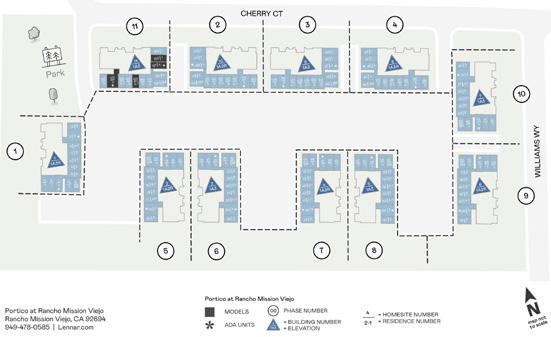
Rancho Mission Viejo’s Portico, built by Lennar, has pushed density to its limits, reaching as high as 27 units per acre. This “stacked condo” product vertically stacks three separate condos with sizes ranging from 727 square feet to 1,377 square feet. Combining smaller square footage with high density has allowed the developer to price these condos starting in the low $400,000s for the smaller units; this is an unprecedented value when compared with the metro area’s median home price, which hovers above $900,000.

Adding an option to rent out a part of the home or have extended family members stay can also bring down the cost of homeownership. In Reed’s Crossing, a Newland community near Portland, Oregon, David Weekley Homes (DWH) is testing out a triplex design that has the option to make the first floor of a two-story townhouse into an independent


41 Contents / Seven Planning Principles for Creating Diverse and Inclusive Communities Creating Diverse and Inclusive Communities
Portico at Rancho Mission Viejo site plan. (Lennar)
First floor plan of the Triplex design by David Weekley Homes in Reed’s Crossing (Oregon). (David Weekley Homes)
Triplex design by David Weekley Homes in Reed’s Crossing. (David Weekley Homes)
Portico at Rancho Mission Viejo. (Rancho Mission Viejo)
dwelling unit, equipped with a kitchenette. These two-bedroom homes range from 1,330 to 1,370 square feet and are priced in the low $400,000s, which is highly attainable compared with the area’s median home price that hovers above $500,000.
Income-Restricted Units
As already discussed, some jurisdictions impose inclusionary housing ordinances, a local government practice that requires and/or incentivizes developers to set aside a certain percentage of units as income-restricted units. A handful of communities— Chatham Park in North Carolina; Briar Chapel, Lakewood Ranch, and Nocatee in Florida; Tehaleh in Washington; and Rancho Mission Viejo in California—have been subject to such ordinances. These communities met the respective ordinances by building income-restricted homes and/or making a payment in lieu. The experience of Chatham Park
is detailed here as it is the most recent and carefully thought out plan to provide low- to moderate-income housing units in a master-planned community.
The developer of Chatham Park, Preston Development Company, has entered into a negotiated agreement with the Town of Pittsboro to provide income-restricted housing. Chatham Park is a 7,068-acre MPC located southwest of North Carolina’s Research Triangle. In keeping with the agreement, the developer will set aside 7.5 percent of the total dwelling units as affordable. Among the 7.5 percent, which totals 1,650 units, 15 percent will be affordable to households earning 60 percent of AMI; 25 percent will be affordable to those earning 80 percent of AMI; and 60 percent will be affordable to those earning 120 percent of AMI. In addition, 90 percent of the units will be multifamily units, and 10 percent will be either detached single-family homes or attached townhouses (Town of Pittsboro 2021). The negotiated agreement

42 Contents / Seven Planning Principles for Creating Diverse and Inclusive Communities Creating Diverse and Inclusive Communities
North Village, Chatham Park (North Carolina) rendering. (Chatham Park Planned Development District, North Village Small Area Plan)
leaves open housing tenure type for all incomerestricted units, and the developer is exploring how to partner with low-income-housing tax credit developers to build mixed-income multifamily apartments.9
Chatham Park’s affordable housing plan is also exemplary for the myriad incentives identified to help offset the cost burden borne by the developers. Most notably, the town has agreed to create a trust fund to collect 2.5 percent of the property taxes of Chatham Park to support the production of the incomerestricted units. The developer will also be eligible for a rebate of all construction and permit-related fees when building the income-restricted units, such as water and sewer system development fees, subdivision plan and site plan review fees, recreation and park fees, and discharge permit fees. There is also a density bonus, which will be in addition to the total number of dwelling units permitted. For each income-restricted unit, a density credit of eight units is allowed, with certain restrictions on the location of the added homes.
The plan does not focus on homeownership; rather, it aims to provide mostly rental and multifamily income-restricted units. This could be a source of criticism. Subsidizing homeownership for lowerincome households and helping them gain wealth is one way to redress socioeconomic and racial inequity. However, building income-restricted rental units and potentially allowing more families to access high-quality neighborhoods that are otherwise inaccessible is another approach to redress inequities. The debate over whether homeownership or other factors of upward mobility should be prioritized is far from settled, and the outcomes of the different approaches will be better understood in the coming decades.
Another shortcoming of Chatham Park’s inclusionary housing plan is that more than half (60 percent) of the units will be available to households earning up to 120 percent of AMI, whereas only 40 percent will be
available to families earning less than 100 percent of AMI. This rent level is still below what the developer would charge for a market rate unit given the new construction and high-quality amenities. However, it does little to make the community accessible to lower-income households.
Ultimately, efforts to support income-restricted affordable housing in an MPC setting must balance need (number of units, income levels, and tenure options) versus the economic viability of providing such units, with a focus on providing housing options that the market truly cannot provide on its own.
As noted repeatedly throughout this report, MPCs are costly to build and maintain, which is often reflected in the high cost of housing. If developers are required to build income-restricted homes without any incentives, they will either walk away from the deal or pass the cost burden on to the market rate units, further pushing up the price of homes. In some communities, where the land has been owned by the development company for decades, if not centuries, the company may be able to offset the cost burden by undercutting the price of land, which is what Lakewood Ranch has done to make the economics work. However, developers that have taken out loans to buy the land do not have such an option. Identifying the many ways the public sector can leverage its resources and power to offset the cost burden holds greater promise for building incomerestricted housing in planned communities.
Regional Variation
Although product innovations were reported throughout the country, certain markets, such as Houston, have been more reluctant to introduce nonconventional products. However, market-leading developers, such as the Howard Hughes Corporation (HHC) and AIRIA Development Company, are pushing the boundaries of product diversification even in the Houston market.
43 Contents / Seven Planning Principles for Creating Diverse and Inclusive Communities Creating Diverse and Inclusive Communities
Heath Melton, regional president at HHC, points out that in the Houston market, it is almost “taboo” to have lots smaller than 50-feet-wide and almost no MPCs have an attached product. Going against the conventional wisdom, he and his team introduced smaller-lot programs and attached products in one of their flagship communities, Bridgeland. Figure 13 shows the range of smaller-lot homes available in that community.
Adding 40- and 45-foot-wide detached single-family products allowed them to bring down the home prices to the low $300,000s and even some below $300,000, making these products attainable for first-time homebuyers. Moreover, HHC introduced townhouses on 28-foot-wide lots and attached twin villas on 40-foot-wide lots, which allowed the company to get the prices down into the mid-to-low $200,000s. The townhouses and villas opened up Bridgeland to demographic groups that wanted to be in an MPC but could not quite afford the 40- and 45-foot-wide lots.

Chris Weekley of DWH shared lessons to consider when introducing these “specialty products” in MPCs. First and foremost, builders should have a firm footing on the ground before introducing

Lot width Builder (feet) Housing type Date Starting price Perry 45 Detached single-family homes 2017 $240,000 Beazer 40 Twin villas 2018 $220,000 Highland 40 Detached single-family homes 2018 $240,000 Chesmar 28 Townhouses 2019 $225,000 David Weekley 35 Alley-loaded homes (garage access from back) 2019 $250,000 David Weekley 42 Alley-loaded homes (garage access from back) 2019 $270,000 Darling 40 Detached single-family homes 2020 $450,000 44 Contents / Seven Planning Principles for Creating Diverse and Inclusive Communities Creating Diverse and Inclusive Communities
Figure 13. Bridgeland’s Smaller-Lot Homes and Prices
Single-family home on a 40-foot-wide lot, built by Darling Homes. (The Howard Hughes Corporation)
Twin villas on a 40-foot-wide lot, built by Beazer. (The Howard Hughes Corporation)
specialty products. That means having a solid pipeline of standard homes they are building and selling in the community to pay for overhead and achieve economies of scale. DWH has successfully tested specialty products on 20 to 30 lots while building a steady stream of more conventional detached single-family homes.

Another important consideration is the placement of the specialty products. Weekley emphasizes that higher-density products need to be located within walking distance of amenities as the homebuyer is making a tradeoff between space and access. This is particularly challenging in the early stages of building the community because the retail and amenity centers are often underdeveloped. In such cases, strategic placement of pocket parks can help to tackle the challenge. Bridgeland sets another good example of placing big and small parks within walking distance of specialty products, which becomes a valuable selling point—especially if the homes do not have large private yards.
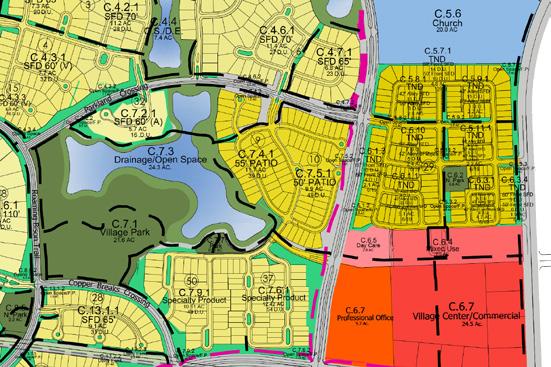
Generation Park also sets an example for the Texas markets. The “Texas doughnut” is a building type commonly found in Texas, with apartments wrapped around parking garages. The typology, when it was first introduced, was touted as a solution for curbing suburban sprawl due to its high density and more appealing facade. However, it has been
criticized for actually contributing to suburban sprawl because this product was being built as islands on large lots in suburban locations. The developers of Generation Park are returning to the original ambition of the Texas doughnut idea. They are incorporating Texas doughnut apartments at the center of the community, where a new town center will be created. Introducing such a high-density product as part of a comprehensively planned community may bring out the full potential of the building type as well as push the boundaries of community development.
Submarket Variation
Regional or national community developers may tackle the attainability challenge by identifying development opportunities in areas that have received less attention for development. This strategy has been successfully employed by Newland and Brookfield. The two companies, now all part of Brookfield, have developed relatively attainable communities in markets where home prices have skyrocketed in recent years, such as Raleigh, North Carolina; Tampa, Florida; and Phoenix, Arizona. Pam Parisi, vice president of marketing at Brookfield Properties, oversees communities throughout the Southeast. She emphasized that having a firm grounding in a metro area is crucial to developing communities beyond the obvious path of growth. Brand recognition
45 Contents / Seven Planning Principles for Creating Diverse and Inclusive Communities Creating Diverse and Inclusive Communities
Bridgeland’s site plan showing higher-density neighborhood with a pocket park to the right. (The Howard Hughes Corporation)
Home built on 35-foot-wide lot, with garage access from rear, built by David Weekley Homes. (The Howard Hughes Corporation)
and trusted relationships with the builders are also important factors that make it possible to venture out to the more pioneering locations.
In the heated housing market of Phoenix, Arizona, for example, Brookfield has two highly successful communities, but they are priced very differently. The average sales price in Alamar, the more attainable community, was $489,323 in March 2022, with the lowest price being $381,900. The average sales price in Eastmark, the premier community, was $702,157 in March 2022. The least expensive option in Eastmark was townhouses, which went for $386,990. Among the detached single-family homes, the most affordable price was $485,900, approximately $100,000 more than the most affordable option in Alamar.
The hard and soft construction costs of homes do not vary significantly between Eastmark and Alamar because they are located in the same market and built by a similar set of builders. However, several
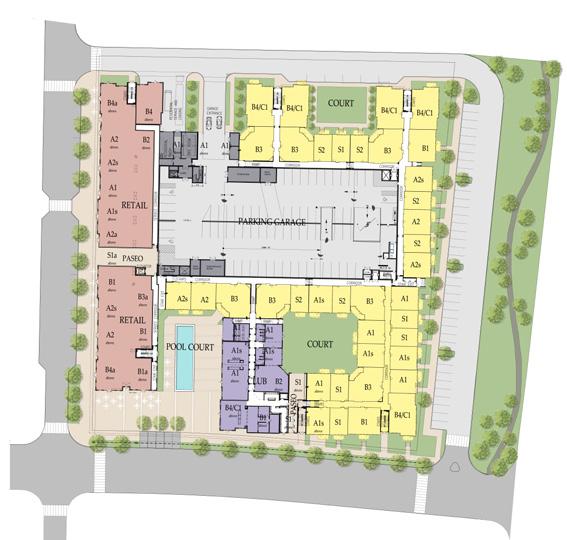
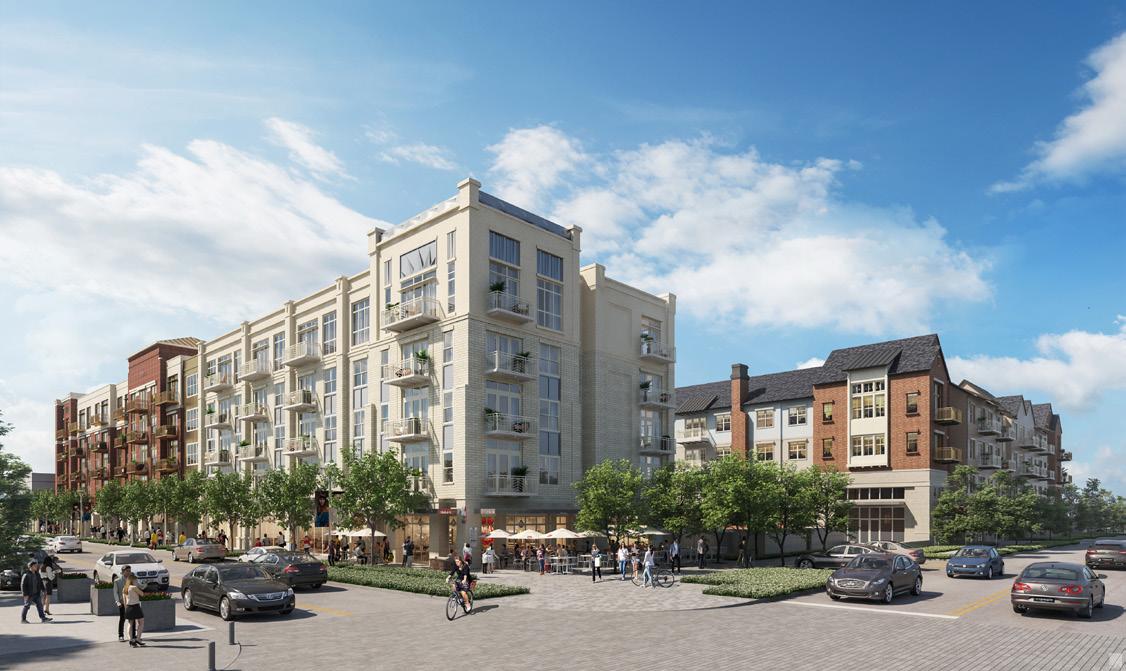
46 Contents / Seven Planning Principles for Creating Diverse and Inclusive Communities Creating Diverse and Inclusive Communities
Rendering of 255 Assay Street at Generation Park. (McCord Development)
255 Assay Street site plan. (McCord Development)
factors contribute to the difference in their pricing. The most critical factor is the price of land. When developing in pioneering locations, developers can acquire land at much lower prices than in the primary locations, which means the per-home cost of land is lower.
Moreover, developers control amenity and infrastructure design. If the construction and maintenance costs for amenities can be lowered, prices of finished lots and HOA dues are also lowered. Rather than offering five clubhouses, for example, the community may have a single community center but lots of parks and open space, which cost less to build and maintain. “There was no vertical amenity in Alamar when the community first opened,” noted John Bradley, Brookfield Residential’s regional
president for Arizona. Instead, Alamar focused on promoting a lifestyle around parks, trails, and outdoor experience. As communities with fewer amenities gain recognition and more residents move in, developers can reassess residents’ needs and introduce vertical amenities later.
Finally, most, if not all, MPCs are developed using bond proceeds for upfront infrastructure costs, and a significant portion of the payments of interest and principal is shifted to the final homebuyers in the form of special assessments. With smart-growth, low-impact design, and other sustainable design principles, the scale and capacity of infrastructure needs can be reduced, which can lower the final home prices.
47 Contents / Seven Planning Principles for Creating Diverse and Inclusive Communities Creating Diverse and Inclusive Communities
4. Prioritize Nature and Open-Space Amenities
MPCs are differentiated from conventional residential subdivisions by the scale and thoughtfulness of the indoor and outdoor amenities they provide. Historically, these amenities have been promoted as exclusive and a luxury—for example, golf clubs, resort-style pools, and clubhouses. However, the community developers’ approach has shifted, according to former executives of Newland, some of whom now hold leadership positions in Brookfield Residential.
“If you draw a line through history, master-planned community development back in the 1980s used to be behind gates, [with] giant monuments, gold, gilded, overbuilt amenities, large pools, giant clubhouses, golf courses—all those sorts of things. That has
changed over time,” said Teri Slavik-Tsuyuki, who headed the former Newland consumer research team and is now an independent consultant to community developers across the country. Peter Dennehy, also formerly at Newland and now vice president of customer and market research at Brookfield Properties, pointed out that vertical amenities have become more modest and practical (such as a gym or a community center for socializing), and amenities are now geared toward nature and open space.
Trails of all sorts—unpaved walking trails, multiuse all-purpose trails, hiking trails, bike trails, and many more—were repeatedly cited as the most-valued asset in contemporary planned communities.


48 Contents / Seven Planning Principles for Creating Diverse and Inclusive Communities Creating Diverse and Inclusive Communities
Challenge trail at Tehaleh, Washington. (Brookfield Properties)
Page excerpt from Tehaleh’s marketing brochure, Tehaleh Guide. (Brookfield Properties)
“Trails are the number one amenity in most of our communities,” noted Bill Meyer, who oversees all Brookfield communities previously developed by the former Newland in the Dallas, Northwest, and Southeast markets. Todd Pokrywa of Viera and Laura Cole of Lakewood Ranch, the second and third largest communities of the studied group, also
confirmed that trail systems are their most-valued asset. The extensive network of trail systems and the total length of the trails now occupy the front pages of the marketing materials. Figure 14 features the communities that pride themselves on having extensive and high-quality trail systems.

Trail length Community size Total units Community name (miles) (acres) at buildout Briar Chapel, North Carolina 25 900 2,700 FishHawk, Florida 25 3,000 6,000 Tehaleh, Washington 30 5,000 9,700 Bridgeland, Texas 250 11,400 20,000 Summerlin, Nevada 150 22,500 80,000 Rancho Mission Viejo, California 12* 23,000 14,000 Lakewood Ranch, Florida 150 30,000 39,968 Viera, Florida 100 43,000 31,619
Figure 14. Total Length of Trail Network in Selected Communities
49 Contents / Seven Planning Principles for Creating Diverse and Inclusive Communities Creating Diverse and Inclusive Communities
*Not including bike trails and pathways in the greenbelts connecting the neighborhoods
Trail map of Rancho Mission Viejo, California. (Rancho Mission Viejo)
The biannual resident survey administered by Rancho Mission Viejo offers a quantitative snapshot of how much homebuyers value outdoor amenities. Rancho Mission Viejo is a 23,000-acre community nestled in the rolling hills of California, surrounded by breathtaking scenery. Over 20,000 acres of the land is forever reserved as a natural habitat reserve. According to the biannual survey, 96 percent of residents responded that they chose the community because of the “nature and open space” and “beauty and serenity” it offers. The survey also asked residents to choose amenities that are “very important,” and two of the top seven amenities were “open spaces” and “paved pathways,” with 94 percent of respondents satisfied with these amenities (see survey image).
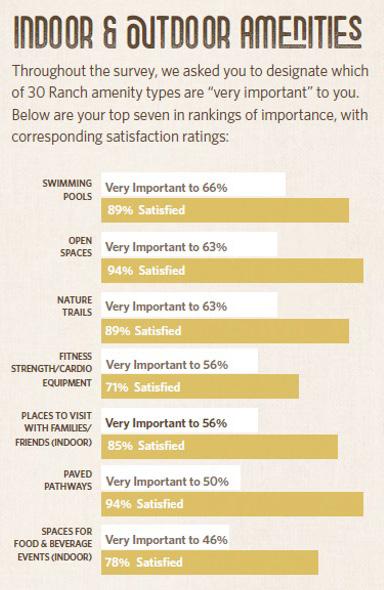
Slavik-Tsuyuki sees two underlying reasons driving the shift in amenity preferences. First, the construction and maintenance costs of luxury amenities add to the cost of homeownership; homebuyers have come to realize the added cost, which discourages them from pursuing lavish amenities. Second, both homebuyers and renters have started to value outdoor amenities such as parks, playgrounds, and trails, a trend that accelerated during the COVID-19 pandemic.
Slavik-Tsuyuki and partners created the America at Home study, a nationwide survey of more than 6,000 Americans.10 They found that both homebuyers and renters value access to small neighborhood parks with seating and playground areas where they can get outside and connect with each other in smaller groups. People want to picnic and barbecue in openair pavilions; they want outdoor fitness spaces. The survey confirmed that health and wellness are at the top of Americans’ minds.
Cutting down the cost of constructing and maintaining vertical amenities, such as clubhouses and pools, undoubtedly helps with housing attainability, but developers can save more, even on outdoor amenities. Heath Melton, HHC regional
president, shared that, historically, MPCs have had highly manicured landscaping that had to be mowed 52 times a year and irrigated all year long. In recent years, HHC’s strategy has shifted to embracing native plants and natural landscapes. In Texas that means the landscaping palette emulates prairie and meadow-like scenery with native plants that thrive in the local climate. This transition is not only environmentally more sustainable, but also economically beneficial because it brings down the cost of maintenance and landscaping. Such cost savings can enhance the overall ecosystem and translate to lower HOA dues.
50 Contents / Seven Planning Principles for Creating Diverse and Inclusive Communities Creating Diverse and Inclusive Communities
Biannual resident survey administered by Rancho Mission Viejo. (Rancho Mission Viejo)
Nature defines Bridgeland community’s identity. Bridgeland boasts the longest trail network among all surveyed communities, even compared with the largest of the communities (see figure 14). Since 2008, it has also hosted an annual Nature Fest, a public event that brings several thousand people to the community to celebrate nature. In addition, fulfilling HHC’s mission to give back to the community, Nature Fest has raised nearly $100,000 for local nonprofits in the Houston area.
The shift toward outdoor amenities and natural landscapes aligns well with diversity and inclusion. In contrast with gated, exclusive clubhouses and golf courses, these parks, trails, and other outdoor amenities are, by definition, nonexcludable. Residents from all walks of life can be seen enjoying the nature-based amenities side by side, often striking up conversations. Such serendipitous
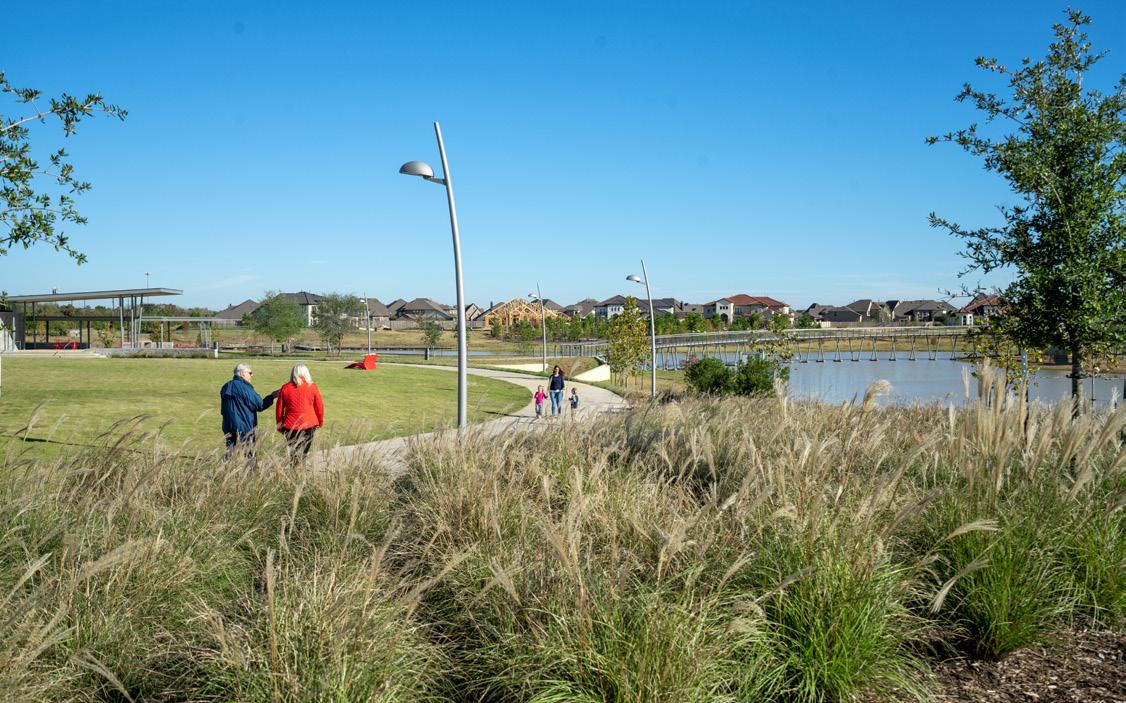
opportunities to connect with people with different backgrounds, ideas, and culture is greatly amplified in the outdoors. Moreover, because these amenities cost less to build and maintain, that helps keep highquality planned communities more accessible to a wider range of income groups.

51 Contents / Seven Planning Principles for Creating Diverse and Inclusive Communities Creating Diverse and Inclusive Communities
Landscaping around Josey Lake, Bridgeland (Texas). (The Howard Hughes Corporation)
Bioswales of Bridgeland. (The Howard Hughes Corporation)
5. Embed Diversity in Company Culture and Values
Another important step community developers can take to create diverse and inclusive communities is to prioritize and commit to the values of diversity, equity, and inclusion (DEI) at the company level. The culture and values of the company will not only be reflected in the community it creates; when the company takes extra steps to diversify its employee base, the company is also setting itself up to serve a more diverse population.
2020 to identify new initiatives that would render the company more diverse and inclusive, and a place where equal opportunity exists for its employees. Results include new DEI training at the management level, an annual company-wide call focused on DEI efforts, and a DEI dashboard on the intranet to share employee demographics as well as the status of various DEI initiatives. HHC tracks and publishes the ratio of women and the ratio of minority employees, both company-wide and in executive positions, to remain accountable and check progress. The company also tracks employee demographics in its regional offices and compares the data with the demographic makeup of the metro areas within which they operate.
The Howard Hughes Corporation sets an example for the industry with its formalized effort to embed diversity, equity, and inclusion in company culture and values. Its DEI effort exists as part of the company’s broader environmental, social, and governance (ESG) platform. HHC sets goals for each ESG area and keeps track of its progress through annual reporting. HHC’s commitment to diversity is in keeping with its history: The company is an amalgamation of the companies founded by the pioneers in community development, such as James Rouse and George Mitchell, who embraced the idea of creating diverse and inclusive communities.
HHC’s DEI efforts are both internal and external. Internally, the company created a DEI Council in
HHC’s summer associates program, created to serve as a feeder system for recruiting diverse talent from across the country, sets a good example. In 2021, approximately half the class of summer associates identified as nonmale and/or a person of color. Clara Kim, vice president of diversity and talent development, works to build talented, diverse summer associate classes every year. Kim noted the program comes with guaranteed, free housing. HHC’s headquarters, where the program takes place, is in The Woodlands, an hour drive from Houston. If not for the guarantee of free housing, many associates would face a significant barrier to fully immersing themselves in the program or would simply not be able to participate. By removing this barrier and ensuring equitable opportunity, HHC provides all summer associates an excellent career development opportunity regardless of their financial situation or family background.
Externally, HHC supports community organizations that are stewards of the environment, promotes education and knowledge building, and works to fill the gaps for underserved populations. For
52 Contents / Seven Planning Principles for Creating Diverse and Inclusive Communities Creating Diverse and Inclusive Communities
“[I]f you put a bunch of old white guys in the room and let them make all the decisions, it’s not going to be a really good business. You’re really going to have to set up a business that is of all different ages, all different races, all different sex. Those are your customers. . . . If you don’t, if the company doesn’t reflect your customer base, how do you know what they want?”
—Craig Collin, Tavistock Development Company
instance, HHC supports HELP of Southern Nevada, a program that assists families and individuals in overcoming barriers and attaining self-sufficiency through direct services, training, and referral to community resources, including a homeless youth center and meal distributions. In the Houston region, HHC provides ongoing support for over 130 local charitable causes through financial donations and volunteerism. In addition to its philanthropic work, HHC provides a community scholarship program in all of its five core regions.


53 Contents / Seven Planning Principles for Creating Diverse and Inclusive Communities Creating Diverse and Inclusive Communities
The Howard Hughes Corporation’s 2021 DEI initiatives. (The Howard Hughes Corporation)
The 2021 cohort of summer associates at HHC. (The Howard Hughes Corporation)

54 Contents / Seven Planning Principles for Creating Diverse and Inclusive Communities Creating Diverse and Inclusive Communities
Employee demographics of the Howard Hughes Corporation. (The Howard Hughes Corporation)
Be Intentional about Marketing to Demographically
Diverse Groups
Marketing, in the context of community development, occurs at two levels: one at the community level, which is undertaken by the community developers, and the other at the house/apartment level, which is undertaken by the homebuilders and apartment developers. Over time, community developers have transferred much of the marketing responsibility to homebuilders and apartment developers, reducing their presence as the community’s marketer. However, Adam Ducker, CEO of RCLCO, believes now is the time for community developers to wrestle back their influence in the marketing realm.
When community developers take the reins in marketing, they can have a greater influence over
the diversity and inclusivity of a community. Creating diverse and inclusive communities, in turn, will strengthen the financial sustainability and profitability of the community as a whole, helping builders sell more homes faster—as argued throughout this report. Ducker recalled that, in the past, builders would often pool their advertising dollars to be used for the marketing of the community. While such practice still takes place occasionally, it is not the norm. Regaining control in marketing by pooling contributions from the builders is another way community developers can nudge the community toward greater diversity and inclusion.

59 Contents / Seven Planning Principles for Creating Diverse and Inclusive Communities Creating Diverse and Inclusive Communities
Marketing image of the Lake Nona community in Florida. (Tavistock Development Company)
Marketing professionals, at both the community level and the house level, must follow the federal Fair Housing Law, which prohibits advertisements that indicate a preference, limitation, or discrimination on the basis of race, color, religion, sex (including gender identity and sexual orientation), disability, familial status, or national origin. The marketing professionals of the surveyed communities strictly adhere to these bounds. They are confident that their community websites and brochures feature images that reasonably represent the majority and minority groups in the metropolitan area. They also ensure that language used in the marketing materials is inclusive and explicitly guarantees equal access to housing.
However, there are impactful ways in which development teams can go above and beyond what is required by the Fair Housing Law. Such action is particularly meaningful given that MPCs are concentrated in southern states where housing discrimination and segregation by race have been particularly pronounced. Brent Gibadlo and Cassie Cataline of Nexton, South Carolina, were particularly keen on racial representation when they prepared the early marketing materials for Nexton.
Despite the development team’s efforts, Nexton’s racial representation falls short, especially in Black representation (see figure 6). Such disproportionate representation reinforces the need to be even more intentional about establishing a multipronged approach to create diverse and inclusive communities. One of those prongs is marketing strategies.
Ironically, marketing professionals can be hamstrung in their capacity to market explicitly to diverse racial and socioeconomic groups precisely because they are bound by the federal and state fair housing laws designed to prevent discriminatory practices. However, marketing leaders have developed creative ways to recruit demographically diverse groups without violating the fair housing laws.
One way to convey the diversity and inclusivity of the community is to leverage the existing residents of the community. “Our goal is to create communities for all,” says Pam Parisi, a vice president of marketing at Brookfield. As a marketing leader, she strives to ensure that when prospective residents are visiting the community, they feel welcomed and accepted into the community. Parisi believes the best way to create such an experience is to be authentic about the character of the community. “We try to feature actual residents in a lot of our marketing across the
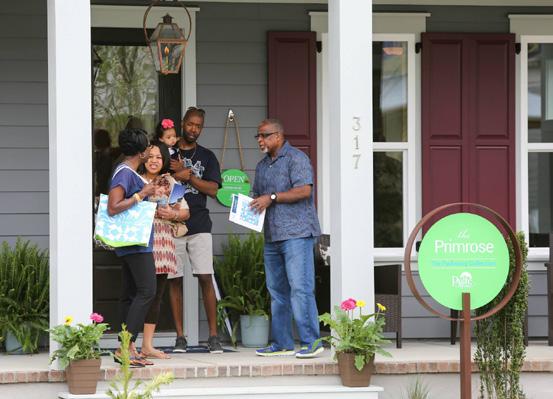
60 Contents / Seven Planning Principles for Creating Diverse and Inclusive Communities Creating Diverse and Inclusive Communities
“South Carolina has the highest percentage of African Americans [of] any state in the country. . . . Over a third of our population is African American, and while [the early marketing materials] had an African American representation, I didn’t think the imagery was representative of that. And we said it would be really smart of us to be more reflective of our immediate constituency and who lives here.”
—Brent Gibadlo, Brookfield Properties
Families visiting homes available in Nexton (South Carolina) during a home showcase event. (Nexton Facebook page, reprinted with permission)
country” and in doing so “we’re very intentional about making sure that we’re representing our diverse audience in the advertisements.” One approach is to feature short interviews of existing residents with diverse backgrounds and interests.11
Tehaleh, a community built by Newland in the Seattle region, has formalized its approach to leveraging current residents to convey a sense of the community. The marketing team created an “ambassador program,” which recruits existing residents to be the champions of the community and meet and interact with prospective residents that come to visit. According to Marita Benedict, the marketing director of Tehaleh, the goal of the ambassador program is to have a group of residents
that represents diverse generation segments, racial and ethnic background, family stages, lifestyle, and occupations to provide an opportunity for prospective residents to ask candid questions about the diversity and inclusivity of the community— questions that often cannot be legally answered by the marketing professionals. Ambassadors are unpaid and are residents who are truly passionate about and invested in Tehaleh.
Marketing professionals nowadays have a broader range of avenues to work with to reach a more diverse population. Social media has become an important marketing tool for all generations; as such, it can be used to convey more intimate insights into the experience of living in the community. Pictures

61 Contents / Seven Planning Principles for Creating Diverse and Inclusive Communities Creating Diverse and Inclusive Communities
Residents featured on the “Resident Stories” page on the community website for Wendell Falls (North Carolina). (Wendell Falls website)
of community and public events are shared on the accounts, and residents often interact with these accounts and posts, amplifying the marketing effect. Given the wide reach of social media, ensuring a diverse representation on social media accounts is particularly important for attracting diverse groups of future residents to the community. Nexton’s team expressed gratitude that their efforts are getting acknowledged by potential and existing residents. Brent Gibadlo shared that they often receive Facebook messages thanking the team for having images of families that “look like mine.”
Vicki Davis of Urban Atlantic noted that the importance of representation starts even before the first shovel hits the ground. She believes the architect’s renderings of proposed developments should feature people of diverse racial and ethnic backgrounds, ages, and family stages that are proportionate to the broader areas in which developments are located. She is adamant in her practice that all the renderings put out to the public by Urban Atlantic feature at least half the people as people of color.

62 Contents / Seven Planning Principles for Creating Diverse and Inclusive Communities Creating Diverse and Inclusive Communities
Eggstravaganza event at Artavia, Texas. (Artavia Facebook page)
Conclusion
This report has analyzed some of the most successful MPCs in the nation to capture the best practices in contemporary community development. Planned communities have long been a test bed for innovative and thought-provoking development practice, leading the real estate industry. However, they have also been the sites of and tools for racial and class discrimination. Community developers have had a central role in inventing, fine-tuning, and popularizing covenants, conditions, and restrictions (CC&Rs) and the HOAs that enforce them.
These mechanisms were purportedly invented to preserve community character and protect property values, but historically they have been used to exclude people based on the color of their skin, nationality, income, or family status. Per Fair Housing laws, CC&Rs and HOAs can no longer be used to discriminate. But they can still be used to create places that are exclusionary, raising concerns that mirror the nationwide debates over exclusionary zoning.
The negative consequences of creating exclusionary MPCs are perhaps even greater than those caused by exclusionary zoning, as MPCs are governed by private, voluntary contracts that run with the homes and the community in perpetuity. It is critical that the master-planned communities of today are designed to become diverse, equitable, and inclusive—setting a better trajectory than in the past. Thus, the research first set out to understand if and how diversity, equity, and inclusion are being considered by community developers.
Surveys and interviews of developers of highly successful communities revealed that forward-thinking community developers are embracing diversity and inclusion. The research identified seven concrete
strategies for making communities diverse and inclusive, which have been elaborated on throughout this report. The central objective was to showcase the best practices so that others working in the field of community development, and suburban residential developments more broadly, can adopt as many of these strategies as possible to nudge their communities toward greater diversity, equity, and inclusion.
Nevertheless, despite the depth and breadth of promising practices identified, even the most innovative and progressive communities have fallen short in advancing equity. This report concludes by discussing this shortcoming. It is relatively easier for community developers to embrace diversity and create places where everyone feels welcomed, which also helps with their business. In contrast, remediating existing racial, ethnic, and socioeconomic inequities is more difficult and has real financial implications. Race and ethnicity have had an intimate relationship with income and social status in the United States; to increase the representation of historically oppressed groups, homes in MPCs must be attainable to lowincome households.
The economics of MPC development and how the capital market functions today do not allow for deeply affordable homes to be built in MPCs without robust subsidies and/or incentives. These communities are expensive to build because of their infrastructure investments and the costs associated with providing high-quality education and lifestyle. The financiers of planned communities expect reasonable returns on their investments; otherwise, they will move on to other investment opportunities. These two conditions together mean that community developers are hamstrung in their capacity to build deeply affordable homes.
63 Contents / Conclusion Creating Diverse and Inclusive Communities
This reality may indicate that significant public intervention is needed to bring down the cost of housing in MPCs. The New Communities experiment of the 1970s set out to do just that; the U.S. government subsidized community developers to create integrated communities that would serve as models for the suburbanization and growth of American cities. Today some people are calling for reparations to begin to compensate for historical injustices; perhaps planned communities can experiment with reparative housing policies and programs.
Community developers face another challenge, even if the money problem is resolved: overcoming the perception and prejudice of the American public when it comes to property value and neighborhood character. Interviewed community developers reported encountering pushback from existing residents—even against market-rate garden-style and multifamily apartments. The American public has long felt that detached single-family homes deserve the highest levels of protection from other land uses and that the presence of lower-income neighbors, denser residential buildings, and commercial uses pose threats to community character and property value.
Such entrenched perception and bias cannot be resolved single-handedly by visionary community developers. Unless these problems are tackled at the national and societal level, creating truly equitable planned communities may be out of reach. But steps can be taken to alter those perceptions and biases. Launching intentional public discourses and education about how properties are valued and questioning the assumptions undergirding existing valuation methods are two steps in the right direction. This report and its findings alone cannot offer fundamental solutions for overcoming the barriers to creating diverse, equitable, and inclusive communities through private actions and market forces. However, by highlighting the challenges, successes, and limitations that community developers face, it hopes to emphasize the need for large-scale public intervention to tackle those barriers and inspire readers to imagine an alternative future of community development.
64 Contents / Conclusion Creating Diverse and Inclusive Communities
List of Surveyed Communities
State Community name Development company Developer type Year opened Total units at buildout Arizona Rancho Sahuarita Rancho Sahuarita Family 2000 9,500 Arizona Verrado DMB Regional 2004 14,080 Arizona Eastmark DMB/Brookfield Regional/ 2013 6,941 National California New Haven Brookfield Residential National 2015 2,102 California Rancho Mission Viejo Rancho Mission Viejo Family 2013 14,000 Colorado Inspiration Brookfield Properties (initially developed National 2007 1,916 by Newland) Florida Bexley Brookfield Properties (initially developed National 2016 1,648 by Newland) Florida Briar Chapel Brookfield Properties (initially developed National 2008 2,700 by Newland) Florida FishHawk Ranch Brookfield Properties (initially developed National 1997 6,000 by Newland by Newland) Florida Waterset by Newland Brookfield Properties (initially developed National 2012 4,500 by Newland) Florida Lakewood Ranch Schroeder-Manatee Ranch Family 1995 39,968 Florida Viera The Viera Company Family 1991 31,619 Florida Nocatee PARC Group Regional 2006 13,500 Florida Lake Nona Tavistock Regional 1998 20,817 Georgia Serenbe Serenbe Family 2004 1,100 Georgia Sterling on the Lake Brookfield Properties (initially developed National 2004 2,022 by Newland) Nevada Summerlin Howard Hughes Corporation National 1990 80,000 North Riverlights Brookfield Properties (initially developed National 2016 3,000 Carolina by Newland) North Wendell Falls Brookfield Properties (initially developed National 2015 4,000 Carolina by Newland) North Chatham Park Preston Development Regional 2021 22,000 Carolina Oregon Reed’s Crossing Brookfield Properties (initially developed National 2019 3,864 by Newland) South Nexton Brookfield Properties (initially developed National 2014 10,000 Carolina by Newland)
65 Creating Diverse and Inclusive Communities continued next page
Appendix
Texas Artavia AIRIA Development Regional 2019 5,200 Texas Canyon Falls Brookfield Properties (initially developed National 2014 2,162 by Newland) Texas Elyson Brookfield Properties (initially developed National 2016 6,000 by Newland) Texas The Grove Frisco Brookfield Properties (initially developed National 2018 2,730 by Newland) Texas Aliana AIRIA Development Regional 2009 4,261 Texas Bridgeland Howard Hughes Corporation National 2006 20,000 Washington Tehaleh Brookfield Properties (initially developed National 2012 9,700 by Newland)
Developer type Year opened Total units
66 Creating Diverse and Inclusive Communities
State Community name Development company
at buildout
Notes
1. RCLCO, “The Top-Selling MPCs: RCLCO Semiannual Reports,” https://www.rclco.com/pub_cat/mpc-reports/.
2. The Bureau of Labor Statistics’ “CPI Inflation Calculator” was used to calculate the inflation adjusted prices. See https://www.bls.gov/data/inflation_calculator.htm.
3. The New Communities experiment refers to the federal program that supported the development of large, mixed-use new urban communities through the issuance of grants and loan guarantees authorized by Title VII of the Urban Growth and New Community Development Act. See the U.S. Department of Housing and Urban Development’s report, An Evaluation of the Federal New Communities Program, for more information.
4. Congress for the New Urbanism, “The Charter of the New Urbanism,” https://www.cnu.org/who-we-are/ charter-new-urbanism
5. Cecilie Rohwedder, “Many House Hunters Are Choosing Diverse Neighborhoods That Reflect a Changing Population,” Wall Street Journal, October 14, 2021, https://www.wsj.com/articles/more-house-hunters-arechoosing-diverse-neighborhoods-that-reflect-a-changing-population-11634157174
6. Labels referring to this financing model vary by state. For example, in Florida, the term is community development district (CDD); in Texas, municipal utility district (MUP); in Nevada, special improvement district (SID); and in Arizona, community facilities district (CFD).
7. See Daniel G. Parolek, Missing Middle Housing: Thinking Big and Building Small to Respond to Today’s Housing Crisis (Washington, DC: Island Press, 2020), https://opticosdesign.com/missing-middle-housing/.
8. Some communities were organized differently and did not keep track of densities at the neighborhood level, which explains the missing data points.
9. During the Chatham Park Check-In on 97.9 The Hill WCHL, founders Tim Smith and Bubba Rawl talk with Vanessa Jenkins, executive vice president of Preston Development Company, about what lies ahead for the community in Chatham County. See Chapelboro.com [97.9 FM], “Affordable Homes at Chatham Park,” Chatham Park Check-In: What Lies Ahead, August 24, 2022, https://chapelboro.com/town-square/ chatham-park-check-in/what-lies-ahead
10. Nancy Keenan, Teri Slavik-Tsuyuki, and Belinda Sward, America at Home Study, 2020, https://americaathomestudy.com/
11. Wendell Falls by Newland, “Resident Stories,” https://www.wendellfalls.com/the-life/resident-stories/.
67 Creating Diverse and Inclusive Communities
References
Bacalao, Patricia, Adam Ducker, Ryan Guerdan, Todd LaRue, Liam Mercer, and Cameron Pawelek. 2021. LowDensity Rental Housing in America. Washington, DC: Urban Land Institute.
Blakely, Edward J., and Mary Gail Snyder. 1997. Fortress America: Gated Communities in the United States. Washington, DC: Brookings Institution Press.
Burby, Raymond J., and Shirley F. Weiss. 1976. New Communities U.S.A. Lexington, MA: Lexington Books.
Cabrera, Joseph F., and Jonathan C. Najarian. 2013. “Can New Urbanism Create Diverse Communities?” Journal of Planning Education and Research 33 (4): 427–41. https://doi.org/10.1177/0739456X13500309
Ducker, Adam, Kelly Mangold, and Lorry Lynn. 2019. Attainable Housing: Challenges, Perceptions, and Solutions. Washington, DC: Urban Land Institute.
Ellis, Cliff. 2002. “The New Urbanism: Critiques and Rebuttals.” Journal of Urban Design 7 (3): 261–91. https://doi.org/10.1080/1357480022000039330.
Ewing, Reid H. 1991. Developing Successful New Communities. Washington, DC: Urban Land Institute.
Fishman, Robert. 2016. “J.C. Nichols’s America: The Suburban World of The Community Builders Handbook.” ULI Americas. https://americas.uli.org/j-c-nicholss-america-suburban-world-community-builders-handbook/
Forsyth, Ann. 2005. Reforming Suburbia: The Planned Communities of Irvine, Columbia, and The Woodlands. Berkeley: University of California Press.
Galatas, Roger, and Jim Barlow. 2004. The Woodlands: The Inside Story of Creating a Better Hometown. Washington, DC: Urban Land Institute.
Garvin, Alexander. 2002. “Introduction.” In Great Planned Communities, edited by Jo Allen Gause. Washington, DC: ULI-the Urban Land Institute.
Gause, Jo Allen, ed. 2002. Great Planned Communities. Washington, DC: Urban Land Institute.
Gause, Jo Allen, ed. 2007. Developing Sustainable Planned Communities. Washington, DC: Urban Land Institute.
Goetz, Edward G. 2010. “Better Neighborhoods, Better Outcomes? Explaining Relocation Outcomes in HOPE VI.” Cityscape 12 (1): 5–31.
Gotham, Kevin Fox. 2000. “Urban Space, Restrictive Covenants and the Origins of Racial Residential Segregation in a US City, 1900–50.” International Journal of Urban and Regional Research 24 (3): 616–33. https://doi.org/10.1111/1468-2427.00268
Grant, Jill, and Katherine Perrott. 2009. “Producing Diversity in a New Urbanism Community: Policy and Practice.” Town Planning Review 80 (3): 267–90. https://doi.org/10.3828/tpr.80.3.3
Griffin, Nathaniel M. 1974. Irvine: The Genesis of a New Community. Washington, DC: Urban Land Institute.
68 Creating Diverse and Inclusive Communities
Jackson, Kenneth T. 1985. Crabgrass Frontier: The Suburbanization of the United States. New York: Oxford University Press.
Kato, Yuki. 2006. “Planning and Social Diversity: Residential Segregation in American New Towns.” Urban Studies 43 (12): 2285–99. https://doi.org/10.1080/00420980600950187.
McCargo, Alanna, Jung Hyun Choi, and Edward Golding. 2019. Building Black Homeownership Bridges: A FivePoint Framework for Reducing the Racial Homeownership Gap. Washington, DC: Urban Institute.
National Housing Law Project. 2002. False HOPE: A Critical Assessment of the HOPE VI Public Housing Redevelopment Program https://www.nhlp.org/files/FalseHOPE.pdf
Platt, Kalvin. 2011. Master-Planned Communities: Lessons from the Developments of Chuck Cobb. Washington, DC: Urban Land Institute.
Popkin, Susan J., Diane K. Levy, and Larry Buron. 2009. “Has Hope VI Transformed Residents’ Lives? New Evidence from the HOPE VI Panel Study.” Housing Studies 24 (4): 477–502. https://doi.org/10.1080/ 02673030902938371.
Rothstein, Richard. 2017. The Color of Law: A Forgotten History of How Our Government Segregated America New York: Liveright Publishing Corporation.
Schmitz, Adrienne, and Lloyd W. Bookout. 1998. Trends and Innovations in Master-Planned Communities Washington, DC: Urban Land Institute.
Schoder, Diana. 2022. 10 Principles for Embedding Racial Equity in Real Estate Development. Washington, DC: Urban Land Institute.
Stark, Courtlynn. 2020. “J. C. Nichols’ Whites-Only Neighborhoods, Boosted by Star’s Founder, Leave Indelible Mark.” Kansas City Star. December 20, 2020. https://www.kansascity.com/news/local/article247787885.html.
Stegman, Michael A., and Mike Loftin. 2021. An Essential Role for Down Payment Assistance in Closing America’s Racial Homeownership and Wealth Gaps. Washington, DC: Urban Institute.
Stevens, Sara. n.d. “J.C. Nichols and the Country Club District: Suburban Aesthetics and Property Values.” The Pendergast Years. Kansas City Public Library. https://pendergastkc.org/article/jc-nichols-and-country-clubdistrict-suburban-aesthetics-and-property-values
Talen, Emily. 2002. “The Social Goals of New Urbanism.” Housing Policy Debate 13 (1): 165–88. https://doi.org/10.1080/10511482.2002.9521438
Town of Pittsboro [North Carolina]. 2021. “Chatham Park Affordable Housing Plan Additional Element.” https://pittsboronc.gov/DocumentCenter/View/1800/Affordable-Housing-12-10-21-PDFpdf.
Urban Land Institute. 1947. The Community Builders Handbook. Washington, DC: Urban Land Institute.
Weiss, Marc A. 2002. The Rise of the Community Builders: The American Real Estate Industry and Urban Land Planning. Washington, DC: Beard Books.
69 Creating Diverse and Inclusive Communities
Interviewees and Survey Participants
This report would not have been possible without the generous time and expertise shared by the interview and survey participants, as well as the industry experts who reviewed the key findings. The Terwilliger Center and author would like to thank the following individuals:
Marita Benedict
Brookfield Properties
Danielle Bisterfeldt
The Howard Hughes Corporation
Garilyn Bourgeois
Brookfield Residential
John Bradley
Brookfield Residential
Jim Carman
The Howard Hughes Corporation
Cristina Carlson
The Howard Hughes Corporation
Cassie Cataline
Brookfield Properties
John Christensen
Cornerstone Communications
Laura Cole
Lakewood Ranch
Craig Collin
Tavistock Development Company
Vicki Davis
Urban Atlantic
Peter Dennehy
Brookfield Properties
Adam Ducker
RCLCO
Gonzalo Echeverria
McCord Development
Hank Fishkind
PFM Group Consulting LLC
Amaya Genaro
Rancho Mission Viejo
Brent Gibadlo
Brookfield Properties
Brent Herrington
DMB Development LLC
Lynneah Hudson
Brookfield Properties
Dan Kelly
DMB Associates
Clara Kim
The Howard Hughes Corporation
Caitlyn Lai-Valenti
Brookfield Residential
Jeremy Laster
Rancho Mission Viejo
Kris Maher
Rancho Mission Viejo
Heath Melton
The Howard Hughes Corporation
Bill Meyer
Brookfield Properties
Mike Miller
The Signorelli Company
Annie Noebel
Cornerstone Communications
Steve Nygren
Serenbe
Gautami Palanki
The Howard Hughes Corporation
Pam Parisi
Brookfield Properties
Rachel Peyton
Brookfield Residential
Kim Phillips
The Howard Hughes Corporation
Todd Pokrywa
The Viera Company
70 Creating Diverse and Inclusive Communities
Justin Robbins
D. R. Horton
Maurice Rudolph
The PARC Group
Jeremy Sharpe
Sharpe and Associates Inc.
Teri Slavik-Tsuyuki
tst ink LLC
Chuck Smith
Preston Development Company
Travis Stone
AIRIA Development Company
Jennifer Taylor
Brookfield Properties
Chris Weekley
David Weekley Homes
71 Creating Diverse and Inclusive Communities
Urban Land Institute 2001 L Street, NW Suite 200 Washington, DC 20036-4948 uli.org









 Aerial image of the Kansas City Country Club District. (Google, ©2022 Maxar Technologies, U.S. Geological Survey, USDA/FPAC/GEO)
Sign for Kansas City Country Club District development, circa early 1900s. (State Historical Society of Missouri-Kansas City)
Aerial image of the Kansas City Country Club District. (Google, ©2022 Maxar Technologies, U.S. Geological Survey, USDA/FPAC/GEO)
Sign for Kansas City Country Club District development, circa early 1900s. (State Historical Society of Missouri-Kansas City)









 Lake Nona land use map. Yellow indicates residential use; purple, red, orange, and blue indicate nonresidential use. (Tavistock Development Company)
Lake Nona land use map. Yellow indicates residential use; purple, red, orange, and blue indicate nonresidential use. (Tavistock Development Company)
















































